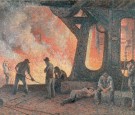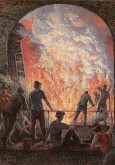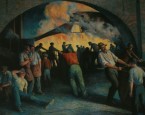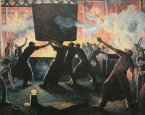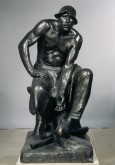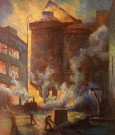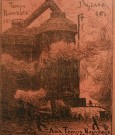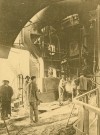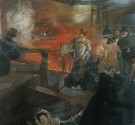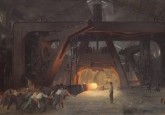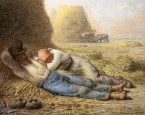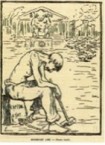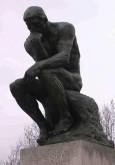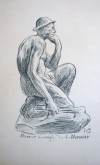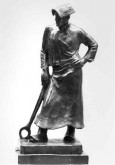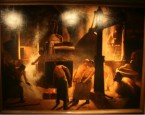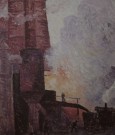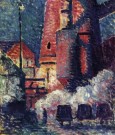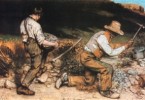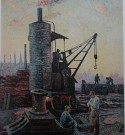The browser will either open the file, download it, or display a dialog.
In L’Aciérie (1900; fig. 1) Maximilien Luce (1858–1941), a Parisian Neo-Impressionist artist and a committed anarchist, represented the blast furnace plant of the Société Anonyme de Marcinelle et Couillet, a large iron and steel plant located in Couillet, near the Belgian town of Charleroi.[1] Seven men work or rest in the factory amid spectacular color, light, and smoke effects. The painter emphasized the orange light emitted by the flow of molten iron from a blast furnace, the modern industrial architecture on the right, and the effects of work on workers. Exhausted, one man lies on the floor. Two workers are seated with slumped shoulders. Another worker, slouching, with arms crossed, watches the active laborer to his left. The blazing light and heat causes one man to shield his eyes and another to drink to relieve his throat.
L’Aciérie is one of more than thirty canvases that Luce painted in the Charleroi area during his several trips there in the late 1890s and early 1900s. Before visiting Charleroi he had exhibited representations of workers in their homes, as well as landscapes, Parisian cityscapes, and industrial suburban views.[2] Although in his pre- and post-Charleroi paintings he frequently represented laborers—usually artisans, stevedores, and construction workers—in Charleroi he depicted mostly industrial landscapes and factory views largely devoid of figures. Luce focused on workers only in L’Aciérie (1900) and three other finished Charleroi paintings—L’Aciérie (1895; fig. 2), Le Gueulard (fig. 3), and La Fonderie (fig. 4). Among these four canvases, L’Aciérie (1900) most forcefully critiques the modern rhythms of factory production.
By studying the contemporary discourses of labor, fatigue, technology, and industrial spectacle, this article shows that L’Aciérie (1900) expresses anarchist ideas about the negative consequences of modern industrial development by emphasizing the degree to which ironwork took its toll on workers. In his effort to demonstrate that modern industry damaged workers’ bodies and psyches, Luce adopted the visual vocabulary of fatigue that the Belgian artist Constantin Meunier (1831–1905) perfected in Le Mineur accroupi (fig. 5) and Le Puddleur (fig. 6), sculptures that Luce reproduced in print after visiting Meunier’s Parisian retrospective in 1896.[3] As the second half of this article shows, Luce’s representations of Charleroi blast furnaces in general can be seen as a critique of the relationship between workers and machines. For example, Hauts Fourneaux à Charleroi (fig. 7) depicts a blast furnace dominating workers with its massive bulk, while producing sublime effects of light, color, and smoke.
Yet by emphasizing the stunning light and color effects of iron production processes, L’Aciérie (1900) suggests Luce’s interest in the visual aspects of ironwork, and conveys his ambivalence toward modern industry. As Luce wrote in his letters, he was terrified by Charleroi yet found it beautiful.[4] He admired its factories and industrial machinery, as he wrote to his friend Henri-Edmond Cross (1856–1910) in 1895: “What is also admirable is the steelworks. I saw a factory: steelworks, blast furnaces, and construction of machines.”[5] Luce’s ambivalence is even more apparent when comparing L’Aciérie (1900) to his three other workers-focused Charleroi canvases, which demonstrate a less critical response to industrial labor. By analyzing Jean Grave’s (1854–1939) anarchist pamphlet Le Machinisme (1898) in relation to its cover, a print by Luce of a blast furnace (fig. 8), this article suggests that Luce’s ambivalence toward modern technology could be understood as echoing anarchist ideas that machines were oppressive to workers in capitalism but essential for alleviating hard labor in a utopian anarchist society.
Through a detailed examination of L’Aciérie (1900) this article revises the existing scholarly view best exemplified by John Hutton’s statement that “Luce’s paintings of industrial labor are striking in that, increasingly, they lacked any critical edge at all.”[6] Hutton reached this conclusion while discussing L’Aciérie (1895) and Le Gueulard (fig. 3).[7] Writing about Le Gueulard in her book Neo-Impressionism and Anarchism in Fin-de-Siècle France, Robyn Roslak reached a similar conclusion. She wrote: “Rather than picturing exhausted or brutalized modern slaves they showcase labor as a collective, manly and self-determined endeavor.”[8] While Luce did not focus on the destructive effects of industrial labor in L’Aciérie (1895), Le Gueulard, or La Fonderie, he did foreground the negative effects of industrial labor in L’Aciérie (1900).[9] Even Le Gueulard includes workers resting in exhausted poses on the left.[10] The purpose of this article is not to deny that some of Luce’s Charleroi paintings portray strong, muscular workers, but to reinstate ambivalence at the heart of the Charleroi project by showing that Luce varied his emphasis, and that he also represented the damaging consequences of industry on workers.
A Parisian of working-class origins, Maximilien Luce became a painter after learning to engrave.[11] In addition to painting, he made anti-government, anti-capitalist, and anti-militarist journal and magazine illustrations throughout his life.[12] Having discovered Charleroi in 1895, when he was visiting Belgium at the invitation of the poet Emile Verhaeren (1855–1916) and the Neo-Impressionist artist Théo van Rysselberghe (1862–1926), Luce returned for three months in 1896, when he painted the greatest number of his Charleroi works.[13] Most canvases represent the Société Anonyme de Marcinelle et Couillet, the only Charleroi factory to which Luce gained access. Charles Jacques, Constantin Meunier’s son-in-law, worked as an engineer there and showed him around.[14] Luce went to Charleroi again in 1897, as indicated by an entry in the journal of his friend Paul Signac, and yet again in 1899 and 1907.[15] He exhibited Charleroi canvases in Paris at the Exposition des Indépendants in 1897 and at Durand-Ruel’s gallery, where he showed thirty-three Charleroi paintings in 1899, and in Brussels at the Libre Esthétique in 1900.[16]
Attraction and Repulsion: The Industrial Area of Charleroi and French Artists
Belgium was the first nation in continental Europe to industrialize and became industrially advanced because of its rich natural resources of coal and metals.[17] Its manufacturing was located in Wallonia, the southern part of the country, where Charleroi was situated. The Charleroi area, in which intensive mining went hand in hand with the development of forges, glass-making factories, and steelworks, supported a third of Belgian industry.[18] The region grew spectacularly during the nineteenth century, in tandem with Belgian cast iron and steel production, which increased over seventy-six times between 1834 and 1889.[19] By the mid-1890s, iron and steel production reached its climax in Belgium as a whole and in Charleroi in particular due to the use of electricity and the transition from cast iron to steel.[20]
Economic development in Charleroi depended on a large class of mining, iron, steel, and glass laborers, who worked in terrible conditions and lived in poverty. Eighty thousand laborers worked in Charleroi at the time of Luce’s visits.[21] Low wages and political disenfranchisement led to a series of strikes in which miners, iron and steel workers, and glass workers took part together, culminating in an 1886 strike that spread to the entire southern part of the country, only to be violently suppressed.[22] To improve working conditions, Belgian workers collaborated with the newly founded Parti Ouvrier Belge (POB), which became the third party of Belgium’s constitutional monarchy in 1885, alongside the Liberal and the Catholic parties. A reformist party, the POB fought to change the constitution, which allowed only male property owners to vote. In 1891 and 1893, two major strikes for suffrage reform, in which the southern industrial workers and miners featured prominently, forced the Belgian Parliament to pass a new law changing the constitution so as to allow all men to vote.[23] As a result, in 1894, twenty-eight POB members were elected to Parliament, eight of them by the inhabitants of Charleroi.[24] The POB members of Parliament immediately started changing the labor laws. As a result of their efforts, Sundays were made non-working days in 1905, and the working hours were reduced from twelve to eight in 1909.[25]
This industrially developed, as well as socially explosive region attracted several French artists. In addition to Luce, Alfred-Philippe Roll (1846–1919), Jules Adler (1865–1952), Pierre Vauthier (1845–1916), and Emile Cagniart (1851–1911) visited Charleroi in search of mining- and industry-related subjects.[26] In a letter to Cross, Luce compared the industrial suburbs of Paris with Charleroi and emphasized the superiority of the latter: “I do not know if you are familiar with this country, I for one had no idea. The environs of Paris, from an industrial point of view, are nothing. St. Denis is just a joke, what character.”[27] Luce went to Charleroi to paint ironworks because Paris was not a major industrial center. He could have visited important French iron and steel producing centers in Le Creusot or Nord-Pas-du-Calais, yet these centers were not as extensive as the Charleroi industrial area. As John Hutton explained, in the 1890s the French economy was still dominated by artisans, farmers, and shopkeepers.[28] In addition, Wallonia was famous as the industrial site par excellence thanks to Meunier’s successful paintings and sculptures, admired by French Neo-Impressionists, and Emile Verhaeren’s poetry, focused on industrial pollution, the increased mechanization of factories, and the disappearance of rural life.[29] Luce knew both sculptor and writer and held their works in great esteem.[30]
French communists and anarchists frustrated by the difficulties encountered in their efforts to achieve social change at home, where strikes occurred frequently in the 1890s, admired Belgians for their civil disobedience and for their ability to secure political representation.[31] French artists traveled to Wallonia to portray strikers. Alfred-Philippe Roll (1846–1919), for example, went to Charleroi to paint Grève des mineurs in 1880. In addition, Belgium offered a safe haven for French anarchists, who were persecuted in their home country after extremist anarchists bombed the French Chamber of Deputies in 1893 and assassinated French president Sadi Carnot in 1894.[32] Luce’s friend Camille Pissarro, also an anarchist, escaped to Belgium in 1894 to avoid capture, as the French police were arresting anarchists indiscriminately.[33] In the 1880s, Luce’s biographer Adolphe Tabarant (1863–1950), an anarchist journalist, art critic, and a founder of the Club de l’Art Social, lived in Belgium, working as a member of the editorial board of POB’s newspaper.[34]
For his role as an illustrator for anarchist magazines, Luce was arrested in July 1894 and sent to prison as part of the effort to enforce the new set of laws, called the lois scélérates, targeting anarchists. Promulgated in retaliation to anarchist bombings, these laws brought to trial intellectuals, writers, and magazine illustrators whose works incited revolt. Luce was imprisoned for six weeks while awaiting trial in the notorious trial called the Procès des Trente, in which he and most others were acquitted.[35] This political climate may also explain why, to paint images of industry, Luce went to Belgium. It would have been difficult for a renowned anarchist to paint inside a French factory at this time. While it would have also been problematic for an anarchist to paint inside a Belgian factory, Luce’s Belgian connections allowed him to gain access to the Société Anonyme de Marcinelle et Couillet. It is unlikely that Luce went to Belgium to avoid another arrest because in January 1895 Félix Faure, the newly elected French president, passed an amnesty law freeing anarchists in French jails and relaxing the harsh lois scélérates.[36]
Danger and Visual Excitement: Representing Ironworks in L’Aciérie
During these politically turbulent times, Luce painted L’Aciérie (1900), which portrays a factory that produced cast iron, steel, rails, and locomotives. Although the title suggests a steel plant, the activity portrayed is a coulée. Translated into English as the running of heats in a blast furnace plant, this operation consisted of emptying a blast furnace of molten iron through a trough in the ground, allowing it to flow into a ladle or into iron beds.[37] The “heats“ refer to the molten metal flowing from the furnace, and the “running” to the passage of metal through troughs. In L’Aciérie (1900) the scene can be identified because of the intense light coming from the flow of molten metal, and from the machinery on the right, an accessory installation of a blast furnace.[38] A similar structure is visible in a postcard showing the tapping of a furnace at the Société Anonyme de Marcinelle et Couillet at the beginning of the twentieth century (fig. 9). The lower part of the blast furnace can be seen in the background on the right, and the trough in the center left. A worker with a shovel controls the flow of iron in front of a metal structure made of two oval openings resembling the metal structure in L’Aciérie (1900).
A coulée started with the tapping of a blast furnace, the removal of a clay plug from the bottom of the furnace that kept it sealed while producing the pig iron, iron that had to be further refined. At least 15,000 kg of molten iron exited in one tapping, which took place twice a day and lasted from a half hour to an hour.[39] The most difficult aspects of a coulée were the removal of the clay plug, the re-insertion of a plug at the end of the process, and the cleaning that followed, as the workers had to break and remove the metal solidifying in the trough.[40] According to historian of iron Jules Garnier (1839–1904), coulées were solemn activities in the factory because they involved handling an enormous mass of molten metal. Blast furnace workers, called fondeurs, would be watching together with the foreman and the engineer: “the moment is always a little solemn; the chief fondeur has brought together all his helpers, the engineer is present.”[41] Coulées were dangerous. If the molten metal looked irregular, the workers’ stress was enormous because metal could flow too rapidly and threaten the workers’ lives. If everything went well, the operation did not require the active participation of all fondeurs. Workers would control the gates allowing the flow of the metal, skim the molten metal with a ringard or rabble, or take a sample.[42]
The tapping of the furnace provided the visual climax of iron-producing operations. While discussing Charleroi factories in his book La Belgique (1888), the Belgian writer Camille Lemonnier (1844–1913) compared the visual spectacle witnessed in the factory to molten suns, lava, and precious metals: “showers of flames . . . shoot their oscillating spirals into space . . . a torrent of lava, flowing step by step like a sun in fusion, rolls its heavy waves into reservoirs, where a large layer of gold and silver slowly becomes immobile.”[43] Yet coulées were difficult to see because they were accompanied by heavy smoke, hurt one’s eyes, and did not last long. Lemonnier described the smog arising out of vapor and smoke together with the reflections off the metal in the following way: “Like a monstrous beast covered by fiery scales and spitting fire through its innumerable mouths, the red mountain advances . . . and immediately men precipitate to meet it, armed with long lances. . . . It is hardly possible to distinguish silhouettes through the fog of vapor and smoke rising in this moment.”[44] The difficulty of seeing through the smoke and flames, as Lemonnier emphasized, made it likely that Luce calculated the best location for his canvas in relation to the activity so as to afford a clear view. As Paul Signac explained in a letter, Luce “is very taken with blast furnaces and the silhouettes of workers, glimpsed through smoke and flames.”[45]
Signac, who accompanied Luce and Charles Jacques to see the tapping of a blast furnace in Couillet in 1897, was thrilled to witness coulées: “Only pastels could render the beauty of this enchantment of flames. There are multi-colored pyrotechnics, fireworks, sparks everywhere . . . workers are nothing any more, I see here the reign of fire! Sunsets, Turners as I see them in a dream, with multiple lightings, rather than the hard labor of poor men, so small, who move through this phantasmagoria. . . . Never have I experienced such joy of color.”[46] Although Signac expressed sympathy for the diminutive “poor men,” he unabashedly admired the molten metal effects, comparing them to sunsets, J. M. W. Turner’s (1775–1851) paintings, and fireworks. The reference to Turner recalls the latter’s Rain, Steam, and Speed: The Great Western Railway (1844), an important precursor to Luce’s painting, portraying the railway in loose brushstrokes and stunning color to suggest sublime excitement and terror in front of the immense power of technology. In a letter to Camille Pissarro, Signac again described this experience: “I haven’t told you my sensations during the descent in the mine, 800 meters down,-but what celebration of color [have I experienced] when visiting the steelworks of Marcinelle and Couillet; It is the symphony of fire. . . . I saw there not the factory black and dirty, but plays of light and colorations like those of the most beautiful sunsets. . . . Man is nothing any more, disappears . . . it is the triumph of fire.”[47] Signac did not dwell on his visit to the mine, where color and light were starkly absent. Instead, he described the factory in the midst of its transformation into a fiery symphony, in which workers seemed to dematerialize.
Although Luce did not explain in detail his impressions while witnessing coulées, he was amazed by the Couillet steel plant. He wrote in a letter: “I saw a factory: steelworks, blast furnace plant, and construction of machines. This is astonishing.”[48] The word Luce used at the end of this quote, “étourdissant,” can be translated not only as astonishing but also as disorienting, deafening, and dizzying, thus signaling a scene visually pleasing and bewildering at the same time. Luce’s description might refer to other factory operations, but it certainly echoes Garnier’s 1878 account of blast furnaces. Garnier explained that the space around them was extremely loud, characterized by “the dull rumble created by the mass of wind that rushes into their large bosoms, and whose noise covers the human voice.”[49]
In L’Aciérie (1900), Luce represented the vibrant light coming from the industrial operation in the background. The left and right halves of the picture, representing labor and rest respectively, vie for attention. The workers on the right attract the viewer by being closer to the picture plane, yet the long tools on the floor in the foreground lead the eye toward the scene of labor, silhouetted against intense light. One of the seven workers uses his rabble, another holds his rabble, and maybe a third, the man standing sideways, rests his arm on another rabble. The other four workers appear unconcerned with the operation. Luce represented the active worker from behind, placing the object of his labor behind the short ledge and the fiery flames. The positioning of the workers suggests that the blast furnace is somewhere on the right, behind the metal structure in the painting, and the metal flows from the right to the left, where a man with a rabble faces it.[50] The metal structure separating the men who are resting from the fiery background dominates workers with its massive presence, suggesting the enormous mass of the blast furnace. The tools on the left—rabbles, a pincer, and a mold used for sampling—suggest activities that have already taken place or that will take place later.
Luce emphasized with a palette dominated by oranges the visual spectacle of the metal flowing from the furnace. Lighter yellow strokes complement the orange, forming a brilliant semi-circle, against which the worker in profile is silhouetted. Above, the incandescence gives way to white and gray smoke, thicker and darker toward the upper left corner. To indicate the overwhelming glow, Luce painted orange strokes over the worker’s bodies, on the factory floor in the foreground, and on the metal machinery to the right. He employed some Neo-Impressionist stylistic devices—the small dots of orange and green on the metal structure on the right, on the workers’ clothes, and on the floor in the foreground, as well as the extreme contrast and silhouetting that separates the contours of depicted forms from the surface of the painting, as in the edges of the machinery on the right.[51] Yet Luce abandoned the rigidity of Neo-Impressionism in his use of looser brushstrokes, visible in the brightest part of the canvas portraying the intense light and smoke. As he explained in a letter, Luce was initially taken aback by the lack of color in Charleroi: “As far as color is concerned, it is almost absent. I cannot see the application of divisionism, so I let myself follow my instinct.”[52] Ironwork scenes challenged his Neo-Impressionist style, from which he broke away during his Charleroi period.[53]
Luce’s choice to depict the factory at the moment of the coulée, one of the few times when it was not dark and bleak, denotes his interest in light effects. Yet while the artist was impressed by the coulée, he depicted the workers in poses that do not show great interest in the visual attractions of the operation. Of the seven workers, only four face the main action. Two are actively working and two are watching in slouched poses: the worker standing in profile, either a fondeur or a foreman, and the man seated in profile. The lack of active viewing on the part of most of the workers in L’Aciérie (1900) contrasts with the absorbed watching depicted in Luce’s earlier canvas L’Aciérie (1895). Here, the artist positioned the viewer behind the workers, looking past them at either a coulée or at a steelworks scene. The main operation takes place in the background, at a remove from the viewer, where three workers portrayed as silhouettes against the light release the molten metal from either a blast furnace or a steel convertor, a large machine that turned cast iron into molten steel.[54] Most of the painting is dedicated to the depiction of pink, orange, and yellow light giving way to abundant bluish smoke above. As in L’Aciérie (1900), the Neo-Impressionist style enhances the luminosity of the scene. Small brushstrokes describe the brilliant atmosphere above the convertor or heats, which are hidden from view. Sprinkled on the factory walls and the workers’ clothes, small pink brushstrokes brighten the composition even further. While one worker holds himself back, away from the light, another worker shown from behind directs a long rabble into the fieriest part of the canvas, from where intense yellow flames surge upward. This dangerous scene is separated from the viewer by a railing that also divides the active workers from the men whose help was not required and who, for their own protection, sit or stand at a remove. The painting invites the viewer to identify with the workers by depicting them with their backs at the picture plane. Yet this positioning also makes it clear that the viewer is an outsider, standing in a spot further removed from the industrial operation and the inactive workers. Of the six spectators, two turn away from the main action and four look straight at the yellow flames. The positioning of the onlookers leads the viewer’s gaze toward the source of light in the painting, depicted behind the head of the seated man in the center. Thus, the worker on the extreme right leans forward on the ledge looking at the industrial operation, and his body creates a diagonal line connecting the corner of the canvas with the center of the painting. Another worker on the left watches the scene in a forward-leaning pose, supporting his arms on the metal railing. The orientation of his body forms a diagonal that parallels the bent leg of the man sitting in the center. The laborer immediately to his right leans back slightly, his arm resting on the metal railing and forming a diagonal descending to the right toward the main source of fire. This diagonal frames the main action on the left, and, together with the diagonal formed by the bodies of the active workers, creates a V-shaped composition at the bottom center of the canvas. The positioning of the main source of visual effects and of the workers highlights the visual excitement of the industrial process: even when resting workmen watch it.
Like Luce’s L’Aciérie paintings, Ernest Georges Bergès’s (1870–1934) Visite à l’usine après une soirée chez le directeur (fig. 10) emphasizes the visual attraction of factory work, yet, unlike Luce’s canvas, it does so by portraying a factory visit. A group of bourgeois men and women stop by a factory located in Saint Etienne in the north of France to admire the fire effects, under the manager’s guidance, after dining at his house.[55] The middle-class visitors watch factory activities from an elevated perspective that asserts the difference between them and the laborers below. Sporting evening gowns, tailcoats, top hats, and fans, the visitors in Bergès’s canvas share the space with a bare-chested worker on the right. The worker stands in front of the woman coming up the steps as if ready to offer his arm to help her. Some visitors converse, while others are absorbed in the act of viewing. Faced with the challenge of portraying the color and light effects that attracted the visitors, the painter covered the air above the factory floor with thin orange glazes giving way to white gauzy lines above. Bergès’s composition encourages the viewer to look past the elegant visitors at the floor below. At least five workers can be identified amid the fiery flames, their presence minimized by the visual spectacle.
Unlike Visite à l’usine, which focuses on the visitors, both of Luce’s L’Aciérie canvases emphasize the challenges faced by workers laboring in the intense heat and light coming from the molten metal. The tremendous light, fiery effects, and smoke suggest the danger and intensity of the operations portrayed. In each canvas one man holds his arm in front of his eyes for protection, suggesting that the strong light is hard to tolerate. In L’Aciérie (1895) a man covers his eyes at the extreme right, standing one step behind the two active workers yet prepared to intervene. In L’Aciérie (1900), the worker covering his eyes stands at the extreme left and is almost engulfed in the fiery orange colors that reflect off his body. Rabble in hand and ready to deal with the flow of metal, he is the only worker painted not as a dark silhouette against the light, but rather merging with the surrounding streams of fire and smoke. Like his double in L’Aciérie (1895) he also protects himself by leaning backward, away from the oncoming flow.
The ironworkers in Luce’s paintings cover their eyes because, unlike present-day workers, who are required to wear dark glasses to avoid damaging their eyesight, nineteenth-century workers refused to wear them.[56] Jules Destrée and Auguste Biernaux’s De la protection des yeux dans l’industrie (1900), a treatise for lawyers and deputies working on Belgian legislation on eye protection, discussed management’s struggle to persuade workers to wear glasses so that factories could avoid paying for medical expenses in case of blinding or injury. Workers shunned glasses because they were uncomfortably hot and heavy, and difficult to see through. In addition, they had to be cleaned often because sweat, vapors, and dust rapidly clouded them.[57]
Luce also underscored the effects of work and the proximity to molten metal on workers by portraying the man on the right of L’Aciérie (1900) refreshing himself with a glass of liquid. Luce had already represented a drinking man in 1895 in Le Gueulard (fig. 3), where a worker sits on the floor on the left in an awkward, exhausted pose, greedily emptying a large drink. Workers had to drink to put up with the great amount of dust they inhaled and to prevent their throats from being burned by the intense heat. In his book on iron, Jules Garnier described how the furnaces altered the factory air, heating it to extreme temperatures and making it hard to breathe: “Always around them [there is] this warm and rarefied atmosphere caused by leaks of wind heated to excess and also millions of calories seeping from this colossus with entrails of fire.”[58] The man in L’Aciérie (1900) may be drinking water from a glass, which may be filled from what looks like a bucket at his feet. He is the only worker who stands up straight, as if the liquid consumed aids his recovery following difficult work. Yet his drinking also recalls alcohol consumption, which, as Dr. Ed. Golebiewski’s Les Accidents du travail en Allemagne (1902) explains, was a major cause of accidents in factories and a major complaint of reformers.[59] In his book Une expérience industrielle de réduction de la journée de travail (1906) the Belgian factory owner Louis G. Fromont wrote that laborers managed to work such long hours only with the help of strong drinks.[60]
Working with molten metal was extremely dangerous because even one drop could cause severe burns and wounds.[61] Ironworkers experienced high mortality rates, as suggested by an article in La Revue d’hygiène et de police sanitaire (1895), which noted: “All ironwork produces a very intense heat, a great quantity of coal, carbon oxide, and a dazzling flash of heated metal. It requires an exaggerated muscular tension, constitutes a danger to life, and is accompanied by frequent traumatisms and burns.”[62] The frequent and sudden changes of temperature and the coal-laden and metallic dust that workers breathed caused most medical problems.[63] The general public was aware of the health problems of iron and steel workers because in Lemonnier’s Happe-Chair (1886), the most famous nineteenth-century novel about ironworks, the main character, Huriaux, a puddler and an otherwise athletic man, suffers from rheumatism, debilitating coughs, and painful skin lesions. He experiences pains that resemble electric shocks, a sign of physical breakdown common in middle-aged and older iron and steel workers.[64]
The many accidents that took place in iron plants contributed greatly to the bad state of workers’ health.[65] In 1895, a major explosion occurred at the Charleroi factory where Luce painted, when water accidentally flew into a crucible of molten iron, sending molten metal flying in all directions and injuring two people.[66] Happe-Chair emphasized the dangerous side of ironwork from its very first scene, in which an old worker, who had already lost his fingers and half of an ear in the factory, dies after being hit in the thigh by an incandescent rail. Later in the novel a massive explosion kills nineteen people.[67]
Luce’s view of the blast furnace plant as a dangerous space, although not as dangerous as Lemonnier’s, was remarkable in French painting. Commissioned by factory owners who wanted to communicate a positive view of industrial labor, most canvases portrayed factories as safe spaces.[68] Compare Luce’s L’Aciérie (1900) with Joseph-Fortuné Layraud’s (1834–1912) Le marteau-pilon: Forges et aciéries de Saint-Chamond (sortie d’une pièce de marine) (fig. 11).[69] This latter painting, commissioned by the director of the forges of St. Chamond and exhibited at the Universal Exhibition of 1889, shows workers pushing a large piece of incandescent metal into a steam hammer to shape it into the crankshaft of a military boat.[70] The laborers perform their collective action in an enormous and immaculate space under the careful watch of the foreman and the military officers on the right. The moment is suspenseful, as the workers have not yet inserted the metal piece into the steam hammer, yet their distance from the incandescent metal suggests that their safety was assured. In the aftermath of the Franco-Prussian War, Layraud’s canvas demonstrates France’s military might and its efforts to supply the army with the most modern machinery.[71] Unlike Layraud, Luce painted in Belgium, thus shunning any possible reading of his works as a celebration of French industry.
Luce and Meunier: Fatigue and Machines
Luce’s portrayal of labor in L’Aciérie (1900) suggests his awareness of the difficult working conditions of fin-de-siècle ironworks. The artist depicted fatigue as the quintessential negative effect of work. A man lies down on his side in front of the metal structure on the right, taking a nap right by his workstation during one of the few moments when workers could lie down without fear of reprimand. His pose resembles that of Jean-François Millet’s fatigued peasant in La Méridienne (fig. 12). Like Millet, Luce denied this man individuality by erasing his facial features and portraying only two slanted lines suggesting closed eyes, and exaggerated his prominent right arm, which equals the man’s legs in length, and covers the lower part of his face. The shoulder looks so round that it almost makes the arm appear detached. This pose suggests a state of fatigue so intense as to make a man impervious to surroundings least conducive to sleep. Luce’s portrayal of this figure suggests the inevitable exhaustion associated with twelve-hour workdays.
Another fatigued worker sits on the right in L’Aciérie (1900), resting his arms on his knees in a pose that Luce had already painted in Le Gueulard (fig. 3) on the extreme left. Dressed in an unbuttoned shirt, Luce’s L’Aciérie worker sits on a ledge, bent over, holding his arms clasped in front of him and gazing at the ground. He is the only man in L’Aciérie facing directly forward, and his facial features are the most individualized. This worker recalls Meunier’s Le Puddleur (fig. 6), a sculpture that Luce engraved on the occasion of Meunier’s retrospective at Siegfried Bing’s Galeries de l’Art Nouveau in Paris, which ran from February to March 1896. The print was published in La Sociale and then reprinted together with nine other prints by Luce after Meunier as an album with the title Les Gueules noires, with an introduction by the anarchist writer Charles Albert.[72] Meunier’s sculpture is an exemplary portrayal of fatigue. The man represented, a half-clothed ironworker with muscular arms and torso, rests in a state of lassitude, catching his breath after a difficult task. He bends forward considerably, letting his right arm, which had been engaged in hard labor, hang loosely in front of his body.[73] Puddlers performed the exhaustive task of refining pig iron, inserting a long rod with a large ball of pig iron at its end into the oven and turning it until all impurities fell to the bottom. Only young, healthy men could accomplish this task because they had to lift and hold enormous amounts of weight.[74]
Luce had already turned the figure type of a seated, bent-over worker into a symbol of capitalist and state oppression in a print published in La Plume in 1893 (fig. 13). Here, a fatigued man sits on a block of marble bearing the inscription “Capital et Etat“ in front of a stock exchange dominated by a monstrous idol and surrounded by smoking chimneys. This weak, thin worker, whose feet are bound together with a chain, bends forward, resting his arms on his legs, letting his head hang low, and staring at the ground. The seated worker in L’Aciérie, while recalling this figure, is far less poignant in his suffering. The Charleroi worker looks tired, yet, unlike the symbolic figure in the print, he is not entirely spent.
The poses of both seated workers in L’Aciérie (1900), and especially that of the worker in the center, suggest resignation, a psychological component of fatigue. The man in the center is silhouetted against the brightest part of the painting, displaying a profile dominated by a rounded back. His surprising closeness to the molten metal suggests a lack of concern for safety combined with interest in watching the scene. Compare his positioning in relation to the molten metal and the active workers to the positioning of Luce’s resting workers in L’Aciérie (1895) in relation to their working colleagues. While in L’Aciérie (1895) workers watch from a distance, the man in L’Aciérie (1900) sits a couple of steps away. His bent back and gesture of resting his head on his hand in the typical pose of melancholia recall Auguste Rodin’s The Thinker (fig. 14), although Luce’s man lacks both the muscularity of Rodin’s figure, especially evident in its nakedness, and its latent energy. The Thinker’s stance suggests an active inner life, while the extreme curvature of the back of Luce’s worker implies fatigue and passivity more than inner activity.
Luce’s figure even more closely resembles Meunier’s Mineur accroupi, another sculpture he had reproduced as an engraving after the Bing show (figs. 5, 15). In the print, Luce reproduced Le Mineur accroupi from the side; when he repeated it in L’Aciérie (1900), he used the same angle. By quoting Meunier’s miner, Luce placed resignation at the center of his canvas, as Le Mineur accroupi was seen in contemporary criticism as resigned and despondent. Art critic André Fontaine described Meunier’s seated miner as: “the aged, thoughtful worker, ready for action and bearing his destiny without revolt . . . a simple, almost sad gravity is nevertheless present; and this old man, in his resting pose similar to his working pose, undoubtedly does not hope for anything good from the future that he accepts: it is the statue of voluntary resignation.”[75] Moreover, in his introduction to Luce’s album of prints after Meunier, Charles Albert wrote: “The sculptor’s most beautiful victory . . . was to have known how to render this face of the modern exploited, made of sadness, despondency, resignation.”[76]
Luce portrayed fatigued and resigned workers to convey a message about modern industry, in line with ideas associated with Meunier’s Parisian show. After he visited this exhibition, Luce wrote that Meunier’s sculptures called into question the view that industrial development was for the best: “At Bing’s, Constantin Meunier exhibition; superb works; sculptures and drawings, mining landscapes, miners, puddlers, and peasants, some groups like “Le Pardon,” “Le Grisou,” works truly superb; from all this an impression of pity and genuinely amazing sadness emerges. I think that revolutionaries will really find their justification here; from a philosophical point of view that makes you think that all is not for the best.”[77] Luce saw Meunier’s works as saturated with ideological meaning. The sadness permeating the Belgian artist’s representations of workers suggested that industrial development and modernity did not improve people’s lives. Although Meunier exhibited works that emphasized fatigue, such as Le Puddleur, he also showed sculptures, such as Le Marteleur (fig. 16), highlighting workers’ physical strength and dignity.[78] Yet the co-existence in the exhibition of sculptures of workers suffering the consequences of industrialization and workers in imposing poses did not prevent Luce from concluding that Meunier’s overall project was to critique working conditions. By quoting Meunier’s works in L’Aciérie (1900), Luce gave visual form to his own ideas and to what he perceived to be Meunier’s ideas about the perniciousness of modern industry. Likewise, Luce’s emphasis on workers’ strength and teamwork in paintings like La Fonderie (fig. 4) does not take away from his critical view of intensive industrialization in general or in L’Aciérie (1900) in particular.
It is not surprising that Luce and Meunier developed a complex imagery of fatigue in the last quarter of the nineteenth century, since fatigue became fully conceptualized by physiologists and politicians during this period. In his book The Human Motor, Anson Rabinbach has shown that fin-de-siècle European physiologists sought to rationalize the laboring body, to annihilate fatigue, and to eliminate inefficient motion. Since European scientists saw the laboring body as analogous to a machine, converting energy into mechanical work, they attempted to find ways to eliminate fatigue and produce energy-conserving laborers.[79] Physiologists sought ways to increase the productive power of labor and maintain energy for longer periods of time. Labor was now understood as labor power, a notion focused on the use of energy.[80] This dehumanizing way to imagine physical labor held that both workers and machines possessed labor power. Karl Marx’s writings predicted the interest in fatigue. If in the 1840s he saw work as man’s exclusive creative impulse, later he saw it as an oppressive necessity and as a limit on freedom and self-realization.[81]
Fatigue came to the forefront as a field of inquiry at the end of the nineteenth century because it was pervasive in modern industry. As factories produced without pause and utilized machines to an unprecedented degree, laborers were forced to work for longer periods of time than ever before.[82] According to Marx, the use of machinery produces fatigue, as it lengthens the working day “beyond all bounds set by human nature. . . . The lightening of the labor . . . becomes a form of torture, since the machine does not free the laborer from work, but deprives the work of all interest.”[83] Working with machines dispossesses the worker of any sense of accomplishment in the industrial process. Since workers are forced to keep up with machines while endlessly repeating their tasks, they tire physically and mentally.
While the workers portrayed in L’Aciérie (1895) and La Fonderie (fig. 4) do not look uninterested or deprived of a feeling of accomplishment, the workers in L’Aciérie (1900), like Meunier’s puddler, are shown suffering due to the modern pace of factory production. Yet Luce’s coulée workers and Meunier’s puddler are exhausted by different tasks. While coulée work demanded physical strength, it required far less robustness than puddling, the most tiring iron-making task. An elite occupation, puddling was becoming obsolete in the late 1890s and early 1900s, when the second industrial revolution witnessed the replacement of traditional skills with machines. Puddling was gradually replaced by large devices for the production of steel—Bessemer (Thomas-Gilchrest) and Martin-Siemens convertors, which transformed multiple tons of molten iron into steel in as little as twenty minutes. Mechanically produced, sturdier steel replaced the puddled iron that had been the most efficient and widely used metal in the second half of the century.[84]
Already in the 1880s Meunier’s critics complained about the increased mechanization of labor when discussing Le Puddleur. In 1887, a French critic writing for La Revue moderne noted that Le Puddleur represented a laborer challenged by intense labor rhythms imposed by new technologies: “This figure . . . is quite the representation of modern labor and of the worker of the nineteenth century, who, due to the division of labor, is but a poorly greased cog, as he sometimes cries; but who cares, we cannot stop the machine for this, let’s go, let’s go, always more.”[85] The critic compared the puddler with a piece of machinery fitting into a large apparatus, physically suffering from his labor, but not allowed to take breaks to recover because the machines he works with could not stop.
For Belgian art historian Arnold Goffin (1863–1934), Meunier’s works implied that the increased use of machines made work harder, while at the same time increasingly desolate:
The formidable organization of modern industry, the use of machines . . . have made labor more difficult, harsher, more fierce, have given it something glacial, scientific, incredibly desolate. It enshrouds with a grand splutter of bitter and somber poetry, taking on the inexorable appearance of a law, sharp as an axiom, insensible as a mechanical organ, this great industry that uses man as if he were an instrument, a tool, a kind of extension of a machine, and confines him, through the division of labor, in an automatic, fragmentary, almost unintelligent labor, reduces him to the state of an agent placed there to feed a furnace with fuel, to deliver to a machine the raw materials that it shapes and manufactures. He no longer knows the joy and stimulation of personal work, of the work begun and continued until its completion and in which, like artisans in the Middle Ages, he would leave the trace of his imagination, his taste, something of himself, finally, that which would make it a living object and not a cold utensil.[86]
Modern industry turned men into extensions of the machine performing an automatic labor that was so fragmented that it did not require use of intelligence. Formerly skilled workers were reduced to day laborers who loaded ovens or delivered raw materials to machines to be manufactured into finished products. Unlike artisans, they no longer knew the personal joy involved in the creation of a product. Similarly, modern products were no longer living objects incorporating the imagination of the worker.
The few critics who reviewed Luce’s works expressed their compassion toward the laborers portrayed in his paintings. In Les Néo-Impressionistes, art critic Gustave Coquiot (1865–1926) described Luce’s paintings as hellish visions dominated by exhausted workers: “Impressive visions of fire and hell, where the victims, half-naked, undergo really overwhelming fatigue.”[87] Impressed by the portrayal of fire effects, Coquiot compared factories to hell and workers to victims: “And this good gniaf Luce has known . . . to erect under the burning vault tall red chimneys, which, although not the steeples of Chartres, are no less moving symbols, furious appeals toward a sky charged with suffering and fire, from where no aid descends for the miserable, exhausted, and winded human beast.”[88] Referring to Emile Zola’s novel La bête humaine (1890), which translates into English as the “human beast,” Coquiot discussed Luce’s laborers as beasts of burden who were at the same time miserable, exhausted, and out of breath.
Socialist art critic Albert Thomas perceived Luce’s factory spaces as terrifying and his machines as threatening. In a passage comparing Luce’s exhibitions in 1899 in Lagny (where no Charleroi paintings were shown) and at Durand-Ruel (where half of the works represented Charleroi), Thomas describes the factories as hellish spaces in which workers resembling Dante’s damned work with monstrous machines:
Maximilien Luce shows us two landscapes of which I do not wish to speak. These unfortunate canvases mark the latest error of the harsh and powerful artist who exhibits today views of Couillet, Marchiennes, Charleroi at Durand-Ruel. How dare I criticize, still having in front of my eyes the terrifying evocation of the Black Country, of those factories, of those plants, of those blast furnaces, of those chimneys vomiting flames, of those fiery windows, of those machines resembling beasts of the apocalypse, of that smoke crossed by lighting, of those slag heaps erected against red skies, of those ingots melted in rivers of fire, of that fiery atmosphere in which men move, wild shadows, damned in a dreadful hell that even Dante had not dreamed! such an oeuvre makes up for all eccentricities, all weaknesses: it carries its author to the front rows among the masters of art nouveau.[89]
For Thomas, the machines depicted by Luce look apocalyptic, the atmosphere is blazing hot, and the workers are but wild shadows moving around a frightening working space. Luce’s paintings inspired anxiety in his critic, who was taken aback both by the representation of fire, smoke, and molten metal, and the laborers’ condition, so dire that it could only be compared to lost souls in hell.
Luce’s critics did not extrapolate on the kinds of fatigue present in L’Aciérie (1900), where the sleeping worker may be suffering from lassitude that can be remedied by a nap, while the seated workers’ resignation denotes a longer lasting fatigue. The reviews of Meunier’s works mention these two kinds of fatigue—lassitude, a temporary state of physical tiredness caused by intense physical effort; and long-term fatigue that permanently damaged the body. For example, Lemonnier saw Le Puddleur as a worker who is resting but ready to continue his task: “Le Puddleur . . . retains the large breath of an undefeated titan who bends in momentary lassitude, but escapes moral pain.”[90] In contrast, Walloon nationalist writer Hubert Krains (1862–1934) argued that Meunier emphasized signs of permanent bodily degeneracy:
In sculpting the modern worker, Meunier . . . created the effigy of modern man, as seen by Schopenhauer and Nietzsche. He always shows us a colossus, but it is a destroyed colossus. No more ample flesh, no more packets of muscles, no more powerful bones. . . . The skin is smelted, the muscles worn out, the bones rusty. The emaciated head falls sadly on the hollow chest; the leg bends under the body’s weight; the half-open hand is immobile and devoid of strength.[91]
According to Krains, Meunier’s workers were defeated colossi. Instead of making their bodies strong or athletic, industrial labor destroys their skin, wears out their muscles, and attacks their bones.
Unlike Meunier’s puddler, Luce’s L’Aciérie (1900) workers perform tasks attesting to their roles as assistants to large machines. They empty a blast furnace that has already produced molten pig iron. While working in twelve-hour shifts, these men serviced as many as nine blast furnaces in one of Belgium’s largest plants.[92] Their tasks consisted of following the daily cycle of blast furnaces, which had to be emptied at clearly appointed times and continuously serviced throughout the day. Fondeurs did not participate in any of the many other factory activities, such as the transformation of iron into steel, and the production of either finished goods like rails and locomotives, or intermediary products like ingots and sheet steel.
Moreover, Luce painted workers assisting machines in L’Aciérie (1895), where they service a furnace or a steel convertor, and in Le Gueulard (fig. 3), where they push carts loaded with raw materials to fill a blast furnace in the background.[93] Luce’s depictions of workers whose tasks were to load and empty machines communicate a message that echoes Marx’s words on the primacy of machines in modern industry: “The machine, which possesses skill and force in the worker’s place, is itself the virtuoso . . . just as the worker consumed food, so the machine consumes coal, oil. . . . The worker’s activity . . . is determined and regulated on all sides by the movement of the machinery, not the other way round.”[94] Luce’s choice of industrial operations portrayed in these canvases suggests his awareness of the primacy of large machinery, either blast furnaces or steel convertors. While furnaces have a long history going hand in hand with the production of iron, they were greatly modernized in the years immediately preceding Luce’s Charleroi visits to produce enormous amounts of iron, often for export. The blast furnaces of the Société Anonyme de Marcinelle et Couillet, for example, produced 92,000 tons of pig iron in 1896. In 1902, the factory built furnaces that could be loaded with raw materials through conveyor belts, making the workers and carts visible in Le Gueulard (fig. 3) obsolete. In 1904, it replaced puddling completely with steel convertors.[95]
Even in La Fonderie (fig. 4) machines are actively involved in the operation. This canvas represents steel casting. Laborers help position a ladle full of molten steel, held by a massive crane invisible in the painting, above ingots below. The artist portrayed the exact moment when the bottom of the ladle is opened so that a strong stream of steel flows into an ingot.[96] These workers’ activity is just one step in a process dependent on the extensive use of machinery. First, convertors transform molten iron into steel, which is poured into ladles weighing several tons. They are in turn transported with the help of massive cranes to the foundry, where their contents are poured into ingots.
Luce may have found inspiration for this painting in Meunier’s La Coulée à Seraing (fig. 17), a large canvas showing the casting of steel ingots next to a Bessemer convertor.[97] Yet in Meunier’s canvas machines share the space with workers. A crane is visible on the left, holding a large cauldron. The dark vertical structure just behind it, in the middle ground, seen between the crane and the central ladle, is a Bessemer convertor shown in action, spewing forth incandescent metal above. Further back in the center, behind the ladle full of molten steel, Meunier represents a worker activating a mechanism that holds the large ladle in the air and allows the molten steel to flow into molds.[98]
While La Fonderie differs from La Coulée à Seraing in its lack of interest in machinery and in its depiction of intense color and light, it echoes Meunier’s portrayal of strong, muscular workers. Meunier’s monumental half-naked figures are in full control of the large machinery around them. Although Luce’s workers are clothed, they look heroic because they are muscular and strong, and because the artist eliminated the crane supporting the ladle, thus making it seem as if the workers hold it. While Luce showed his admiration for workers in La Fonderie, in L’Aciérie (1900) he was more concerned with the effects of labor on their bodies. The men in this canvas do not look as muscular, strong, determined, or proud as the workers in La Fonderie. Slumped shoulders and bent-over poses replace the sturdy and straight backs of the workers of the 1898 painting. In L’Aciérie (1900) laborers look like average men tired from hard work.
Luce depicted fatigued and resting workers to suggest that there were limits to what they could endure. Unlike La Coulée à Seraing, in which each worker has a clearly assigned role, L’Aciérie (1900) includes workers who are not working. In Meunier’s canvas each man stands for a specific role in the industrial processes of steel production and casting. Luce’s inactive bodies, on the other hand, could be seen as resisting the rhythms of production with which they were forced to keep up, following Rabinbach’s assertion that fatigue was a “sign of the body’s refusal to bend to the disciplines of modern industrial society.”[99]
While Meunier evoked classical precedents, Luce emptied his works of mythological references. Albert Mockel (1866–1945) felt that Le Puddleur referred to “the admirable bronze in the Terme Museum in Rome,”[100] and Lemonnier asserted that “Meunier’s worker has as its origins Olympic athleticism.”[101] Furthermore, unlike Meunier, in L’Aciérie (1900) Luce eschewed the glorification of labor. Lemonnier had written that Meunier’s workers were symbols of men’s endurance in the face of unsurpassable obstacles: “These modern Cyclops represent a sort of cosmic myth suggesting the antagonism between the elements and man’s power. . . . They are symbols of man in their rapport with forces. . . . They especially typify the endurance of races faced with the fatalities of labor.”[102] In addition, while Meunier’s critics claimed that his workers express a heroic struggle against all odds, Luce’s L’Aciérie (1900) workers do not invite optimistic musings. Walloon art critic Charles Delchevalerie wrote that Meunier represented the worker
extenuated, because it [the human beast] exerts . . . its life resources royally; he never shows it defeated. A formidable hope springs from the view of these colossi buttressed in gigantic tasks or bent by fatigue. . . . In their gnarled musculatures lie the unconscious and secret reserves of races who subdue destiny, they are the innumerable men who long ago built the pyramids and who produce today, swarmingly and silently, more useful and not less wonderful miracles.[103]
Delchevalerie argued that Meunier’s fatigued workers did not look defeated, but rather resembled the builders of pyramids, who were overworked to achieve a great task. To Delchevalerie their sacrifice seemed worthwhile for society as a whole.
Luce echoed the opinions of French anarchists who wrote about the Meunier show. In his review in La Revue rouge, for example, Manuel Devaldès (1875–1956) complained that bourgeois visitors to the Bing exhibition interpreted Meunier’s works as an exaltation of labor. He argued that the difficult realities of factory work should not be glossed over, since they were an essential aspect of Meunier’s works:
Glorification of labor! Yes, for the artist and for some, the latter voluntarily affected by blindness; but for me there is furthermore the evocation of the horrifying social problem and of the life of those who slave away from youth until death to eat black bread and procure for their masters the necessary, the superfluous, and the insolent luxury. Oh! Cowardice bringing forth ignorance.[104]
Devaldès was outraged that the audiences of Meunier’s exhibition, “the posh bourgeoisie and aristocracy, the famous trendsetters,” admired Le Puddleur and Le Marteleur for their beauty, while turning a blind eye to such laborers’ horrible working conditions.[105] He vigorously asserted that the present organization of society and the ownership of means of production by capitalists led to the exploitation of workers pushed to total exhaustion.[106] Aware of such anarchist critiques, Luce ensured that his representation of industrial labor in L’Aciérie (1900) could not be interpreted as an invitation to adulate workers’ muscular bodies.
Luce articulated his awareness of the central role of machines in modern ironworks by painting at least eight canvases of blast furnaces shown from a distance. A letter from 1898 written by Signac attests to Luce’s interest in these colossal structures: “Luce spent two months in Charleroi. He is very taken with the blast furnaces.”[107] His portrayals of blast furnaces emphasize the grandeur of these structures towering above workers in an intimidating manner.[108] In Hauts Fourneaux à Charleroi (fig. 7) the rails in the foreground lead the view directly to a blast furnace on the left, and one of its Cowpers, regenerators used to preheat the air before injecting it in the blast furnace, on the right.[109] The viewer faces the furnace standing between an older brick building on the right and a modern building housing the steelworks on the left. The other pieces of machinery depicted are a potence, a mechanism used for loading and unloading wagons, on the right, and a small locomotive used for moving large containers with molten metal or slag, on the left.[110] The sublimity of the blast furnace is emphasized by the contrast between its size and that of the three workers in the foreground, painted in a few quick brushstrokes. The man on the right shovels raw materials; the other two men are portrayed walking. Their small size contrasts greatly with the enormous mass of the industrial buildings and furnaces, implying their irrelevance in a highly industrialized world. Furthermore, the sublime power of modern industry is suggested through the light and smoke coming from a coulée performed on the opposite side of the blast furnace. The orange blaze circles the furnace like a halo, lighting up the windows of the factory on the left, while dense smoke rises against the dark mass of the furnace in the middle ground. The light coming from the flow of molten metal eclipses the light from the arc lamp above the building on the left.[111] Luce chose a time of day characterized by low light to make the contrast between the relative darkness, and the light coming from the coulée and the electric lamp even more dramatic.
Although the blast furnace in Hauts Fourneaux à Couilllet, la coulée (fig. 18) is cut off by the left and top edges of the canvas, it still towers forcefully above the workers. Luce dedicated more than half of the canvas to the visual effects accompanying the coulée taking place on the other side of the furnace. Intense yellow light at the bottom gives way to a large cloud of bluish-purple smoke above. Luce silhouetted another blast furnace operation, the evacuation du laitier, or the discharge of slag, against the light and smoke. A by-product of pig iron production made of ash and mixed oxides of silicon, phosphorus, and sulfur, slag was regularly taken out of the furnace and dumped. In Luce’s painting, a chenal, or half-open conduit, juts out from the bottom of the furnace on the right, allowing the slag to flow into a cuve à laitier, or slag tank. To the right of the slag tank a small locomotive puffs, ready to move when the tank is full.[112] A worker is silhouetted on a railing at the same level as the conduit, watching the operation to ensure its success.
In Charleroi, Hauts Fourneaux (fig. 19), Luce painted the discharge of dust, another moment in the daily cycle of a blast furnace. The operation can be identified by the prominence of the conical structure tapering at the bottom, called a bouteille à poussière, or dust cyclone, an accessory installation of the furnace whose role was to separate the dust from gas. Luce painted the exact moment when the dust is released into the large containers below, surrounded by a massive cloud of white dust.[113] Here, the furnace is again cut off by the upper edge of the canvas, yet its massive size dwarfs the two workers on the left. The representation of these three different furnace operations—coulées, discharge of slag, and discharge of dust—suggests that Luce had a good understanding of blast furnace technology.
It is not surprising that Luce represented the grandeur of modern industrial structures, since he explained in his letters that he found the Charleroi area grand and poetic. When he visited Sotteville, a suburb of Rouen, and compared it to Charleroi, Luce stressed the superiority of the latter: “Dear God Sotteville seemed a sad place! What miserable population! In addition, the landscape has no character. It lacks the poetry of industrial towns in Belgium. It lacks grandeur, it is sad and banal.”[114] Luce and Cross, who only knew Charleroi from hearsay, considered that the Charleroi area had a decorative beauty difficult to address in painting. In an 1896 letter to Luce, Cross stated: “You seem to have your head full of beautiful projects inspired from the Black Country now. That part of Belgium must actually be singularly suggestive of beauty and force. I still remember its evocation by the interesting sculptor Meunier while conversing at the opening of the exhibition at Champ de Mars. Here the aspects of nature are less solemn. That looks rather like fairyland, as you well know. The difficulty lies in extracting this decorative beauty.”[115] Cross, who seems to repeat what he had already heard from Luce and Meunier, called the industrial area around Charleroi grand, beautiful, forceful, and grave. This quote suggests that French artists appreciated Charleroi because of its sublime and spectacular aspects.
Luce’s thoughts on blast furnaces may have echoed those of his friend Signac. On the occasion of his visit to Charleroi with Luce, Signac also wrote that he admired the architecture of the factory, which he considered more eminently modern than recent Parisian architecture. He wrote: “Because of their grandeur and utility, these blast furnaces end up having great architectural style. This architecture of iron and fire is the only one of our epoch. Between the Trinity and this factory, why hesitate.”[116] In a letter to Camille Pissarro, he added: “Don’t you find that these blast furnaces express great force and utility, and end up having style. They seem to me, these terrible cathedrals of labor, to be the only laudable specimens of modern architecture.”[117] Signac expressed admiration for blast furnaces because they were an example of functional architecture, pragmatic and utilitarian.
Yet, Luce’s portrayal of blast furnaces in print form suggests a more negative outlook. In a lithograph accompanying Verhaeren’s poem La Ville de la douleur published in the Parisian anarchist publication Almanach du père Peinard in 1897, Luce portrayed blast furnaces as symbols of oppressive capitalism (fig. 20). The poem evokes an oppressive imaginary city whose houses contain the pain of the workers who built them. Tall towers, symbols of state and Church corruption, dominate this anxiety-ridden metropolis.[118] Made of geometrical pieces of granite, the city’s towers are about to be torched:
This is the city of pain
But flames become mixed with tears
And the fire is there, torch or flame.
. . .
Already on the tower steps
Run
People with fire between their knuckles,
. . .
They display over there where no law or bible
Has maintained its fallible symbols,
In full golden sky, whose stars all move,
Violently the devastating red flower.[119]
Luce’s illustration shows the city in the background, a river on the right, and a group of workers in the foreground. The skyline is dominated by tall factory chimneys on the left, a blast furnace in the center, a church tower behind it, topped by a cross, and a tall roof reminiscent of the Paris City Hall on its left. Luce’s city combines architectural elements that did not actually exist in the same place. The bridges on the right are reminiscent of bridges over the Seine and the shape of the tall roof left of center suggests the mansard roofs of Parisian architecture. The blast furnaces between them, however, are not a Parisian fixture. They were transposed from Luce’s representations of Charleroi, and so were the vigorous fumes covering the skyline. This combination of buildings and sites denotes not a particular place but the concept of a modern technological city. Luce, who was a close friend of Verhaeren, illustrated the poet’s notion of the modern city evoked in the volume of verses Les villes tentaculaires (1895).[120] Such a city made of large, indestructible factories, covered by smoke, and drowned in terrible noise oppressed its working-class inhabitants. Yet in La Ville de la douleur, a poem that was not included in Les villes tentaculaires, Verhaeren evoked an oppressive city without calling forth any industrial imagery. By including blast furnaces in the lithograph, Luce took liberties with Verhaeren’s poem while drawing on the poet’s earlier imagery. This insertion of industrial elements implies that for Luce blast furnaces were necessary to create an image of working-class anguish.
Signs of revolt dominate the foreground, where a group laments the death of a man shown in a supine pose on the right. A worker sits on the left holding his head in his arms, bent forward, not unlike Luce’s worker in the Capital et Etat print, yet resting his head on his arms. A woman collapses on his knee, while the man in the center points to the cause of their troubles, the blast furnaces in the background, and the church behind them. Luce toned down the vision of inflammatory crowds suggested so forcefully by Verhaeren’s poem. A crowd advancing toward the city by the river is barely visible in the print. The artist did illustrate incendiary anarchist ideas in L’Incendiaire, a print published in Les Temps Nouveaux in 1896, together with verses by Verhaeren about a visionary about to burn down a village. According to Hutton, this print refers to a common theme in the press, the explosive side of anarchist ideology. It suggests that the old world needs to be destroyed and replaced with a new society.[121] By representing symbols of the state, Church, and modern industry—the three major culprits of capitalism—in the print associated with La Ville de la douleur, Luce created an image of the modern city that must be destroyed.
While L’Aciérie (1900) expressed ideas critical of modern industry much more subtly than Luce’s prints, it conveyed a revolutionary political meaning as well. According to Signac, a painting like L’Aciérie (1900) communicated radical ideas through its Neo-Impressionist style and by representing workers in a factory, which was, in Signac’s view an excellent choice of modern subject matter. When Signac wrote about the social and political role of Neo-Impressionist artists, he referred to La Forge (1890), Luce’s only representation of factory work painted before Charleroi, as a canvas with revolutionary aims:
Through their new technique, the reverse of established rules, they showed the vanity of immutable methods; through their picturesque studies of working-class neighborhoods like Saint-Ouen or Montrouge, sordid and dazzling, through the reproduction of large and curiously-colored silhouettes of a roadworker next to a heap of sand, of a forge worker in the incandescence of a forge, or even better through the synthetic representation of decadent pleasures: balls, chahuts, circuses like those made by the painter Seurat, they brought their testimony to the grand social process which takes place between laborers and Capital.[122]
Signac saw Luce’s paintings and those of Neo-Impressionist artists in general as providing critical social commentary on fin-de-siècle life by representing the modern aspects of urban life in an honest manner. The artist-turned-theorist explained that artists did not have to represent social issues directly to make a statement about their social and political opinions. The Neo-Impressionist style would suffice: “It would thus be an error, committed too frequently by best-intentioned revolutionaries like Proudhon to demand systematically a precise social tendency in works of art, as this tendency is found much more powerful and eloquent in pure aesthetes, revolutionaries by temperament, who stray off the beaten path, paint what they see, as they feel it, and often give, unconsciously, a solid pickaxe blow to the old social edifice.”[123] For Signac, the social meaning of works of art came from expressing the artist’s temperament and unique mode of seeing the world, rather than from their subject matter. Following their temperament allowed artists to paint in new ways, forcefully challenging accepted ideas, albeit sometimes in an unconscious manner.
Signac disagreed with the anarchist writer Pierre-Joseph Proudhon, who had written in Du principe de l’art et sa destination sociale (1875) that it was the explicit social content of works of art that was essential, while their formal aspects were less important: “In painting . . . the idea is the main thing, the dominant. . . . The question of depth takes precedence over that of form. . . . In all art creation before judging the matter of taste one must exhaust the debate over ideas.”[124] For Proudhon, art could and should help improve mankind. Proudhon found Gustave Courbet’s works exemplary because their truthful depictions of a broken world challenged viewers to think of solutions.[125]
By portraying the fatigue of modern labor, Luce’s L’Aciérie (1900) fulfilled Proudhon’s dictates as well. Proudhon, who responded to Courbet’s The Stonebreakers (fig. 21) through a tirade about the negative effects of machines in society and their failure to bring relief to workers, would have found Luce’s painting inspirational. Confronted with Courbet’s image of backbreaking labor, Proudhon ironized industrial development, unable to produce machines for all human labors. Even if such machinery were possible, Proudhon argued that it would never function without people, and ultimately it would lead to the enslavement of workers: “Our machines . . . replace us with a huge advantage. There is only one reproach to be made . . . they must be watched, governed and even served. Or who is the servant of machines? Man. Man as a serf, that is the last word of modern industrialization.”[126]
Machines in Anarchist Thought
A review of the ways in which anarchists generally conceptualized machines reveals contradictory views as to their usefulness. Proudhon, who wrote early in the century, was steadfastly against them, complaining that the increased use of machines left workers without jobs and increased their misery. Nevertheless, as the immediately preceding quotation suggests, he recognized that they had a “huge advantage.”[127] Later anarchist writers like Verhaeren, Pierre Kropotkin, and Jean Grave were equally ambivalent about technology. For example, Verhaeren’s early poems, whose industrial imagery greatly inspired Luce, forcefully articulated his hatred of machines, while his later poems praised them.[128] La Plaine, published in 1893 in the volume Les Campagnes Hallucinées, decries the automation of laborers toiling far from the sun in multi-story factories. Here, Verhaeren compared workers to components of large machines. Their eyes have become the eyes of the machine, while their entire bodies submit themselves to the rule of iron and steel. Sleepless and fatigued, machine-like men affixed to the factory floor damage their hands working with molten metal.[129] Yet poems like L’Effort (1907) present workers who have mastered machines, and with their help achieve great progress.[130]
Kropotkin tried to reform anarchist theory to incorporate a measure of industrial technology in his ideal society, yet he extolled the virtues of rural life. According to Kropotkin, in an ideal society people would engage in both intellectual and manual activities performed equally in the fields and in workshops.[131] He saw the future of social production not in giant urban or suburban factories but in small, decentralized industries and trades dotted across the countryside.[132] In Fields, Factories, and Workshops (1912), he wrote:
Have the factory and the workshop at the gates of your fields and gardens, and work in them. Not those large establishments, of course, in which huge masses of metals have to be dealt with and which are better placed at certain spots indicated by Nature, but the countless variety of workshops and factories which are required to satisfy the infinite diversity of tastes among civilized men. Not those factories in which children lose all the appearance of children in the atmosphere of industrial hell, but those airy and hygienic, and consequently, economical, factories . . . factories and workshops into which men, women, and children will not be driven by hunger, but will be attracted by the desire of finding an activity suited to their tastes, and where, aided by the motor and the machine, they will choose the branch of activity which best suits their inclinations.[133]
As this passage suggests, Kropotkin excluded the large ironworks that Luce painted from his ideal vision of a society made of a mixture of fields and workshops. He conceded their necessity in modern life and saw them as exceptional sites that needed to be placed close to the source of raw materials. For Kropotkin, all factories in which people had to work should be hygienic, economical, and appealing to workers who would work for pleasure, not out of necessity. In an anarchist society machines would help workers perform the tasks that they chose to perform.[134] The production of cast iron and steel did not fit neatly in Kropotkin’s vision of transitioning from large-scale factories to small workshops.
Grave’s pamphlet Le Machinisme (1898), a reprint of a chapter published in Grave’s book La Société Future (1895), argued that machines injured workers in a capitalist society yet were capable of lightening hard labor in an ideal society. Le Machinisme was published by the French anarchist magazine Les Temps Nouveaux with a cover illustrated by Luce depicting a Charleroi blast furnace (fig. 8). The pamphlet begins by stating Grave’s agreement with Marx that working with machines had negative consequences for laborers: “Spending the entire day following the progress of a machine to see coming out a piece of ironwork all embossed is not recreational nor enriches the brain, and, while this work is repeated every day without break or rest, year after year, one can see that he who has done only this all his life is incapable of anything else if this occupation ends, and this incapacity puts him at the mercy of his exploiter.”[135] Grave explained that the tasks that men undertook repeatedly during their work were conducive to stagnation, as workers did not learn anything in the process nor were they able to enjoy their labor. Furthermore, laborers became unskilled. Their bodies were so robotically wedded to their task that if their employment ended, their lack of know-how and inability to change put them at the mercy of capitalists. Like Marx, Grave recognized that because machines required a certain kind of attention from workers who had to keep up with them, their labor became even more tiring than when workers had to do without machines.[136] Workers hated machines because they put them out of work, diminished their salaries, and made them compete with each other for the little amount of work left over.[137]
Less than halfway through his text, however, Grave reversed direction, explaining that the fault did not lie in machines but in the social organization of society:
But are they those you should blame for all this evil? Are they the ones you should reproach for taking your place? -Would you not be satisfied to have to only cross your arms and watch them produce in your stead? . . . The machine is a problem in present-day society because you have masters who have known how to turn to their profit all the improvements that man’s industrial genius has brought to the means of production. If these machines belonged to everyone . . . you would make them produce without breaks or pause, and the more they produced, the happier you would be, because you could satisfy all your needs. Your production would know no limits other than your ability to consume. When your warehouses were full . . . you would enjoy your holidays in peace.[138]
Grave explained that machines could alleviate hard labor in an ideal society, in which they would be equally owned. The capitalist organization of labor was the real cause of proletarian misery. In an equitable society machines would shorten the working day and the amount of effort necessary for production. Society would produce only what it needs. Unlike factory managers who would stop machines and put people out of work when the stores were full for fear of driving prices down, laborers would work until everyone was fed and then they would rest and enjoy the products of their labor. The rhythm of work would be set by people’s needs, not by random market forces. In an ideal society machines would be a blessing: “In these circumstances machines would be beneficial to you. Then, it is not they who are the cause of your misery, but those whom they serve as means of exploitation. Comrades in misery . . . attack the real causes of your misery, the capitalist organization that makes of you machines of machines; but do not curse this equipment that will free you of natural forces if you free yourselves from those that exploit you.”[139] According to Grave, machines are not the cause of workers’ misery, but the means of exploitation. Workers should instead attack the root of the problem—the capitalist system.
Luce’s print for Grave’s text greatly resembles his canvas Hauts Fourneaux à Couilllet, la coulée (fig. 18), painted three years before. The artist’s choice to illustrate a booklet on machinisme with a blast furnace suggests that he saw the furnace as the prototypical example of a machine, especially as Grave did not mention blast furnaces. In fact, to focus on the furnace at the expense of any other kind of machinery, Luce cut off the small locomotive situated on the right in Hauts Fourneaux à Couilllet, la coulée (fig. 18). He also modified the print in relation to the painting to include the entire shape of the blast furnace and one of its Cowpers, thus making the industrial structures easier to recognize. Smoke rises on the right and drifts in front of the furnace and Cowper. By prominently adding a light fixture above the furnace on the right, Luce included electricity in his conceptualization of machinisme.
Grave’s discussion of machines as detrimental to workers in present-day society yet helpful in a utopian anarchist society sheds light on Luce’s representations of blast furnaces. Luce’s portrayal of a blast furnace in La Ville de la douleur is unambiguously negative because in this print the furnace functions as a symbol of capitalism. The painter’s choice to illustrate Le Machinisme with a blast furnace, on the other hand, suggests that he found the blast furnace emblematic of Grave’s concept of a machine that could be oppressive to workers yet also useful. Luce’s ambivalence toward blast furnaces, which he called admirable in one of his letters, yet also represented critically, can be explained as echoing anarchist thinkers’ general stance on machines. Although fully aware of the negative effects on workers of working with modern machinery, Luce probably agreed with Grave that modern technology was not inherently deleterious. Like Kropotkin, Luce may have found the iron and steel producing industry both necessary and difficult to reform. Aware that machines could make workers’ lives easier, the artist represented machines alleviating hard labor in Usine à Charleroi (fig. 22), where a steam-engine crane makes it possible for one man to lift heavy metal parts, while two workers in the foreground take a break. Both L’Aciérie paintings (figs. 1, 2), Hauts Fourneaux à Charleroi (fig. 7), and Hauts Fourneaux à Couilllet, la coulée (fig. 18), all reveal visual fascination with machines, the fire and smoke effects surrounding them, and their complex functioning, and a concern about their effects on workers. L’Aciérie (1900) most remarkably brings together the artist’s interest in stunning light and color effects, his appreciation of industrial architecture, and his awareness that ironwork caused fatigue, eye problems, dejection, and resignation. Yet, Luce’s ambivalence toward technology, as expressed in his letters and paintings, was lost on his critics, who saw his Charleroi paintings as critical of industrial labor.[140] While they admired the artist’s ability to portray hellish, yet impressive, factory processes accompanied by unique effects of light and smoke, they expressed sympathy for workers and dismay at the changes brought about by industrialization.[141] They decried the unfortunate circumstances of modern labor while conceding that Luce’s paintings expressed a nascent industrial aesthetic.[142]
I thank Nina Athanassoglou-Kallmyer and Margaret Werth for their challenging questions and encouragement. This project could not have evolved in its current form without the support I received from the Fulbright program and the Getty Research Institute. Special thanks go to Philippe Tomsin, François Pasquasy, and Pascal Lefèbvre for helping me identify the industrial structures and processes in Maximilien Luce’s paintings.
Translations are by the author.
[1] Paul Signac identified the factory he visited together with Luce as the steelworks of Marcinelle et Couillet. See Letter Signac to Pissarro, November 26, 1897, 870524, Getty Research Institute, Los Angeles. The title of this painting, L’Aciérie, or Steelworks, is inaccurate, as Luce did not represent a steel plant, but a blast furnace plant. The title may refer to the entire factory, which comprised a blast furnace plant, steelworks, and construction workshops. See Société Anonyme de Marcinelle et Couillet, Rapport du Conseil d’Administration sur le Bilan arête au 30 Juin 1896, AEM.15.019 – 8, Archives de l’Etat, Mons.
[2] See Robyn Roslak, Neo-Impressionism and Anarchism in Fin-de-Siècle France (Aldershot: Ashgate, 2007) for a detailed analysis of these works.
[3] These works’ titles translate into English as The Puddler and The Crouching Miner. On Luce’s prints after Meunier see Stephen Brown, “Luce: The Artist Engagé” (PhD diss., Columbia University, 2003), 76.
[4] Luce wrote: “J’ai eu depuis que je suis à Charleroi, un peu de découragement ou une paresse terrible. Ce pays m’épouvante. Chaque fois que j’y vais et que je revois les choses déjà vues, je n’ose me mettre à la besogne. C’est tellement terrible et beau que je doute de rendre ce que j’y vois, et avec cela d’une difficulté épouvantable.” See Robert Rousseau, “Maximilien Luce et la Belgique: Un Néo-Impressionniste au Pays Noir,” in Palais des Beaux-Arts de Charleroi, Maximilien Luce: Tricentenaire de Charleroi, exh. cat. (Charleroi, 1966), n.p. John Hutton has also noted Luce’s “conflicting impressions.” See John Gary Hutton, Neo-Impressionism and the Search for Solid Ground: Art, Science, and Anarchism in Fin-De-Siècle France (Baton Rouge: Louisiana State University Press, 1994), 175.
[5] “Ce qu’il y a d’admirable aussi, ce sont les aciéries. J’ai vu une usine: aciérie, fonte et construction de machines.” Luce to Henri-Edmond Cross, 1895, ODO 2007.10.26, Musée d’Orsay, Paris. Luce had already explained earlier in his letter that he found the Charleroi area itself admirable.
[6] Hutton, Neo-Impressionism, 185.
[7] Ibid. For the latter canvas I am using the title Le Gueulard because it is most appropriate. The painting portrays the gueulard, or mouth of the furnace. Situated at the top of the furnace, the gueulard allowed workers to feed the furnace from the top with iron, coal, and chemical compounds. Although this painting by Luce does not represent a foundry or a coulée (which occurs at the bottom of the furnace), its official title in the Luce catalogue is Fonderie à Charleroi, la coulée. Many of the titles of Luce’s Charleroi paintings are misleading.
[8] Roslak, Neo-Impressionism, 175.
[9] The title of La Fonderie is accurate and can be translated into English as The Foundry.
[10] Baillargeon has already noted that Le Gueulard is characterized by the contrast between active and resting figures. See Camille Baillargeon, “La Représentation des ouvriers des forges, mines et usines dans la peinture française de 1871 à 1901” (MA thesis, Université de Québec, 2002), 154.
[11] For biographical information on Luce see Jean Sutter, Maximilien Luce: Peintre anarchiste (Paris: Galerie des Vosges, 1986); Adolphe Tabarant, Maximilien Luce (Paris: G. Crès, 1928); and Jean Bouin-Luce and Denise Bazetoux, Maximilien Luce: Catalogue raisonné de l’œuvre peint (Paris: Editions JBL, 1986).
[12] For an analysis of Luce’s magazine illustrations see Brown, “Luce: The Artist Engagé;” Aline Dardel, “La révolte ou le drapeau noir: Luce, Camille, et Lucien Pissarro,” La Gazette de l’Hotel Druout, no. 44, December 11, 1981; Aline Dardel, “Le mouvement anarchiste et la propagande par l’image,” in Maximilien Luce, (1858–1941): Peintre anarchiste, ed. Jean-Jacques Heirwegh, Jean-François Füeg, and Raymond du Moulin, exh. cat. (Brussels: Université Libre de Bruxelles, Institut de Sociologie, 1995), 31–46; and Aline Dardel, Les Temps Nouveaux, 1895–1914: Un hebdomadaire anarchiste et la propagande par image, exh. cat. (Paris: Editions de la Réunion des Musées Nationaux, 1987).
[13] Jean-François Füeg, “A Charleroi,” in Heirwegh, Füeg, and du Moulin, Maximilien Luce, (1858–1941), 23; Rousseau, “Maximilien Luce,” n. p.; and Marina Ferretti Bocquillon, Maximilien Luce néo-impressionniste: Rétrospective, exh. cat. (Giverny: Musées des Impressionismes, 2010), 19.
[14] Luce’s friend Emile Verhaeren asked Meunier to intervene so that Luce could access the factory. In a letter from 1895 or 1896 Meunier asked his son-in-law to facilitate for the “peintre français l’entrée de l’usine. Je pense que son intention est d’y faire quelques études.” Meunier to Charles Jacques, quoted in Artcurial Briest-Le Fur-Poulain-F. Tajan, Livres et manuscrits précieux: collection de Josette Day, bibliothèque de Monsieur P., archives Théodore Koenig, correspondance de Maximilien Luce (Paris: Artcurial Briest, Le Fur, Poulain, F. Tajan, 2007), 18. Meunier wrote to Verhaeren in 1895: “J’ai reçu ton mot et j’ai immédiatement écrit à Jacques pour ton ami Luce.” Meunier to Verhaeren, 1895, 3.198, Les Archives de l’Art Contemporain, Brussels, Royal Museums of Fine Art of Belgium, Brussels.
[15] Signac mentioned the 1897 date. See Journal Signac, November 15-December 17, 1897, Archives Signac; quoted in Ferretti Bocquillon, Maximilien Luce, 19. The 1899 and 1907 dates are mentioned in Rousseau, “Maximilien Luce,” n. p.
[16] Theo Van Ryssselberghe asked the organizer, Octave Maus, to dedicate a part of the exhibition to Luce’s Charleroi paintings. Van Rysselberghe to Maus, November 16, 1899, quoted in Rousseau, “Maximilien Luce,” n. p.
[17] Pierre Lebrun, “La révolution industrielle,” in Crédit Communal de Belgique, L’industrie en Belgique: Deux siècles d’évolution, 1780–1980 (Brussels: Crédit Communal de Belgique, Société Nationale de Crédit à l’Industrie, 1981), 25; and B. S. Chlepner, Cent Ans d’Histoire Sociale en Belgique (Brussels: Université Libre, 1958), 48.
[18] Serge Jaumain, “Une lente et timide démocratisation de la société belge, 1886–1914,” in Industrialisation et sociétés, 1830–1970: La Belgique (Paris: Ellipses, 1998), 354; and Sutter, Maximilien Luce: Peintre anarchiste, 28.
[19] Annick Brauman, ed., Art et société en Belgique, exh. cat. (Charleroi: Palais des Beaux-Artsde Charleroi, 1980), 14.
[20] Ibid., 33; Jean Gadisseur, “Le triomphe industriel,” in Crédit Communal de Belgique, L’industrie en Belgique, 70–76.
[21] Füeg, “A Charleroi,” 24.
[22] Brauman, Art et société en Belgique, 20.
[23] Janet L. Polasky, “A Revolution for Socialist Reforms: The Belgian General Strike for Universal Suffrage,” Journal for Contemporary History 27, no. 3 (1992): 452–53.
[24] Brauman, Art et société en Belgique, 23; and Füeg, “A Charleroi,” 24.
[25] Els Witte and Jan Craeybeckx, La Belgique Politique de 1830 à nos jours (Brussels: Labor, 1987), 124.
[26] Patrick Descamps, ed., Des plaines à l’usine: Images du travail dans la peinture française de 1870 à 1914, exh. cat. (Paris: Somogy Editions d’Art, 2004), 104.
[27] “Je ne sais si vous connaissez ce pays, mais je ne m’en faisais pas une idée. Les environs de Paris, au point de vue industriel, ne sont rien. St. Denis n’est que de la blague, quel caractère.” Luce to Cross, 1895, ODO 2007.10.26, Musée d’Orsay, Paris.
[28] Hutton, Neo-Impressionism, 72.
[29] Paul Signac, for example, wrote in 1891 “Je me hâte de témoigner de ma sincère admiration pour ce sculpteur [Meunier] qui est non seulement un grand artiste, mais encore un esprit élevé—ses œuvres le prouvent.” See Paul Signac [Un camarade impressionniste, pseud.], “Variétés, Impressionnistes et révolutionnaires,” La Révolte, June 13, 1891, 4. Verhaeren decried industrial development in his volumes of poetry Les Campagnes Hallucinées (1893) and Les Villes Tentaculaires (1895), especially in the poems La Plaine and Les Usines.
[30] On Luce’s relation with Verhaeren and opinions on his poetry see Luce’s letters to Cross at the Musée d’Orsay, Paris. Luce wrote: “Je vais aussi de temps en temps chez Verhaeren. Nous causons. J’ai passé des moments bien agréables avec lui. Quel homme simple et charmant. En voila un qui fait des beau vers, et n’a rien de tous ces emmerdeurs mystiques, symbolistes, et autres. Je me suis trouvé être de son avis sur beaucoup de choses, entre autres celle-ci qu’il faut absolument en revenir à la vie, qui est la source de tout art.” Luce to Cross, undated. If Luce did not meet Meunier when he traveled to Brussels or at the exhibition of Meunier’s works in Paris at Siegfried Bing’s Galeries de l’Art Nouveau in February or March 1896, he definitely met the Belgian artist in Couillet at the factory where Charles Jacques worked between July and October 1896. See the letter from Luce to Cross: “Nous avons passé deux bonnes journées ensemble. Quel homme, mon vieux, quelle santé artistique! En voilà un qui tient des vieux et des grands!” Luce to Cross, quoted in Rousseau, “Maximilien Luce,” n. p.
[31] Edward Shorter and Charles Tilly, Strikes in France, 1830–1968 (Cambridge: Cambridge University Press, 1974), 110; and Polasky, “Revolution for Socialist Reforms,” 453–54.
[32] Reginald Carr, Anarchism in France: The Case of Octave Mirbeau (Manchester: McGill-Queen’s University Press, 1977), 60–61.
[33] Sutter, Maximilien Luce: Peintre anarchiste, 70.
[34] Jean-François Füeg, “Un peintre anarchiste au Pays Noir,” in Heirwegh, Füeg, and du Moulin, Maximilien Luce, (1858–1941), 28; and Paul Aron, Les Ecrivains belges et le socialisme, 1880–1913: L’expérience de l’art social d’Edmond Picard à Émile Verhaeren (Brussels: Labor, 1985), 53.
[35] Sutter, Maximilien Luce: Peintre anarchiste, 68–72.
[36] Ibid., 76.
[37] I thank Ron Baraff for his help identifying this scene.
[38] A sketch for this canvas portraying the same metal structure in front of a blast furnace bears the title Hauts Fourneaux à Charleroi (1890s; cat. no. 1064 in Bouin-Luce and Bazetoux, Maximilien Luce), thus positioning this structure in a blast furnace plant. Yet it has not been possible to figure out the exact purpose of this structure.
[39] Jules Garnier, Le Fer (Paris: Hachette, 1878), 164.
[40] I thank François Pasquasy, blast furnace engineer in the Liège area, for explaining this process to me.
[41] Garnier, Le Fer, 164. In the original: “le moment est toujours un peu solennel; le maître fondeur a réuni tous ses aides, l’ingénieur est présent.”
[42] Oral communication with François Pasquasy, March 2012.
[43] “Des gerbes de flammes . . . dardent leurs oscillantes spirales dans l’espace. . . . un torrent de lave, coulant de proche en proche comme du soleil en fusion, roule ses lourdes vagues dans des réservoirs où lentement s’immobilise une large nappe d’or et d’argent.” Camille Lemonnier, La Belgique (Paris: Hachette, 1888), 479.
[44] “Comme une bête monstrueuse imbriquée d’écailles ardentes et crachant le feu par d’innombrables gueules, la rouge montagne s’avance . . . et aussitôt des hommes se précipitent à sa rencontre, armés de longues lances . . . C’est à peine si, dans le brouillard de vapeur et de fumée qui s’élève en ce moment, on distingue encore les silhouettes.” Ibid., 486.
[45] Luce “est très pris par les hauts fourneaux et par les silhouettes de travailleurs, entrevues parmi les fumées et les flammes.” Signac to Bardier, September 26, 1898, 850911, Getty Research Institute, Los Angeles.
[46] “Il faudrait des pastels pour rendre la beauté de cette féerie de flammes. Partout des feux de Bengale multicolores, des feux d’artifices (sic), des étincelles . . . les ouvriers ne sont plus rien, je vois là le règne du feu! Des couchers de soleils, des Turner comme je les rêve, aux éclairages multiples, plutôt que le dur labeur des pauvres hommes, si petits qui circulent dans cette fantasmagorie. . . . Jamais je ne crois je n’ai eu une pareille joie de couleur!” Journal Signac, Archives Signac, November15-December 17, 1897, quoted in Ferretti Bocquillon, Maximilien Luce, 19.
[47] “Je ne vous disais pas mes sensations de la descente dans une mine, au fond a 800m,- mais quelle fête de couleur, en visitant l’aciérie de Marcinelle et Couillet: C’est la symphonie du feu . . . J’y ai vu non l’usine noire et sale, mais des jeux de lumière, et de colorations comme dans les plus beaux soleil couchants. . . . L’homme n’est plus rien, disparaît . . . c’est le triomphe du feu.” Signac to Pissarro, November 26, 1897, 870524, Getty Research Institute, Los Angeles.
[48] “J’ai vu une usine: aciérie, fonte et construction de machines. Cela est étourdissant.” Luce to Cross, 1895, ODO 2007.10.26, Musée d’Orsay, Paris.
[49] “Le grondement sourd que fait la masse de vent qui s’engouffre dans leur vaste poitrine et dont le bruit est tel qu’il couvre la parole humaine.“ Garnier, Le Fer, 164.
[50] In a small oil on carton, La Fonderie (1890s; cat. no. 1060 in Bouin-Luce and Bazetoux, Maximilien Luce), Luce depicted a coulée from a location perpendicular on the flow of metal. Here the molten iron advances toward the viewer from the furnace in the background. The worker on the right adjusts the gates, while the man on the left takes a sample of pig iron.
[51] According to Neo-Impressionist color theory, the mixture of dots of color created an increased luminosity in the viewer’s eyes. Neo-Impressionists drew on Michel Chevreul’s De la loi du contraste simultané des couleurs (1839), Ogden Rood’s Modern Chromatics (1879), and Charles Henry’s Le cercle chromatique (1889). See Roslak, Neo-Impressionism, 17 for an in-depth discussion of Neo-Impressionist color theories.
[52] “Quant à la couleur, elle est à peu près absente. Je ne vois guère d’application de la division, aussi je me laisse aller à mon instinct.” Luce to Cross, 1895, ODO 2007.10.26, Musée d’Orsay, Paris.
[53] For a detailed analysis of Luce’s abandonment of Neo-Impressionism in Charleroi see Emile Verhaeren, “Exposition Maximilien Luce (Galerie Durand-Ruel du 16 au 31 Octobre 1899),” La Revue Blanche, October 15, 1899, 309–11; and Beatrice de Verneilh, “Maximilien Luce: Epoque Néo-impressionniste” (PhD diss., Université de Paris-Sorbonne, Paris IV, 1979–1980).
[54] The factory Luce painted had acquired Thomas-Gilchrest convertors for the automated production of steel in 1891-2 and had an operational Martin-Siemens steel plant at the time of Luce’s visits. See Robert Halleux, Cockerill: Deux Siècles de technologie (Liège: Editions du Perron, 2002), 90.
[55] Baillargeon, “La Représentation des ouvriers,” 179.
[56] S. Broido, “Revue des journaux: De la métallurgie du fer au point de vue sanitaire, par M. Sviatlowsky,” Revue d’hygiène et de police sanitaire, no. 17, 1895.
[57] Jules Destrée and Auguste Biernaux, De la protection des yeux dans l’industrie (Brussels: Veuve Ferdinand Larcier, 1900), 13, 20.
[58] “Toujours autour d’eux cette atmosphère chaude et raréfiée que produisent les fuites du vent chauffé à outrance et aussi les millions des calories que sue ce colosse aux entrailles de feu.“ Garnier, Le Fer, 164.
[59] Ed. Golebiewski, “Les Accidents du travail en Allemagne,” trans. Paul Riche, Annales 47 (1902): 106, 107.
[60] Louis G. Fromont, Une expérience industrielle de réduction de la journée de travail (Brussels, Leipzig, and Paris: Misch and Thron, 1906), 20.
[61] I thank François Pasquasy for explaining to me the danger of the operation.
[62] Broido, “Revue des journaux: De la métallurgie,” 90–91.
[63] S. Broido, “Revue des journaux: Influence des travaux dans les usines métallurgiques sur la fréquence de la pneumonie chez les ouvriers, par M. D. Nikolsky,” Journal russe d’hygiène publique, de médecine légale et pratique 27, no. 2 (1895): 764.
[64] CamilleLemonnier, Happe-Chair (1885; repr. Brussels: Labor, 1994), 109, 249.
[65] Golebiewski, Les Accidents du travail, 107.
[66] La Gazette de Charleroi, September 9, 1895.
[67] Lemonnier, Happe-Chair, 1, 5, 363.
[68] During the Third Republic, the French state promoted academic painting illustrating French industrial successes and acquired Jules Aviat’s Les forgerons (1882), Ferdinand Gueldry’s Une fonderie: les mouleurs (1886), Fernand Cormon’s La forge, and André Rixens’s Laminage de l’acier, établissements de Wendel à Hayange, enfournement et défournement des lingots. See Baillargeon, “La Représentation des ouvriers,” xiv, 23, 61–62.
[69] The title of the canvas can be translated into English as The Steam Hammer: The Forges and Steelworks of Saint-Chamond (the emergence of a ship component).
[70] Nicolas Pierrot and Marie-Laure Griffaton, “Peindre dans l’usine, 1760–1890,” La revue du Musée des Arts et Métiers 36 (September 2002), 4.
[71] Ibid.
[72] For a detailed discussion of Luce’s prints see Brown, “Luce: The Artist Engagé,” 76. The title Gueules noires referred to the representations of miners in the album. Translated literally as “black mouths,” the term was used for miners because they came out of the mine covered in coal dust.
[73] Sura Levine and Françoise Urban, Hommage à Constantin Meunier, 1831–1905 (Anvers: Galerie Maurice Tzwern-Pandora, 1998), 23.
[74] Sura Levine, “Monumental Transformations: The Changing Status of Constantin Meunier’s Monument to Labor” (PhD diss., University of Chicago, 1996), 123.
[75] “Le travailleur âgé, pensif, prêt à l’action et qui subit sa destinée sans révolte . . . une gravité simple, presque triste, s’y affirme quand même; et ce vieillard, dans sa posture de repos toute proche de celle du travail, n’espère sans doute rien d’heureux de l’avenir qu’il accepte: c’est la statue de la Résignation volontaire.” André Fontaine, Constantin Meunier (Paris: F. Alcan, 1923), 121.
[76] “La plus belle victoire du sculpteur . . . est d’avoir su rendre cette face de l’exploité moderne, faite de tristesse, d’accablement, de résignation.” Charles Albert, introduction to Gueules Noires, dessins de Maximilien Luce d’après l’oeuvre de Constantin Meunier (Paris: La Sociale 1896), n.p.
[77] “Chez Bing, exposition de Constantin Meunier; choses superbes: sculptures et dessins, paysages miniers, houilleurs, puddleurs et paysans, quelques groupes tels que “Le Pardon,” “Le Grisou,” des choses vraiment superbes; il se dégage de tout cela une impression de pitié et de tristesse vraiment étonnante. Je pense que les révolutionnaires y trouveront vraiment leur compte; au point de vue philosophique, cela vous fait penser que tout n’est pas pour le mieux.“ Luce to Cross, 1896, quoted in Rousseau, “Maximilien Luce,” n.p. Le Pardon (Forgiveness) is not an industrial sculptural group. Le Grisou (The Firedamp) represents a mother bent over in pain over the dead body of her son, a miner who was killed in a firedamp explosion.
[78] This title translates into English as The Hammerman.
[79] Anson Rabinbach, The Human Motor: Energy, Fatigue, and the Origins of Modernity (New York: BasicBooks, 1990), 2.
[80] Ibid., 4, 78, 117.
[81] Ibid., 72.
[82] Peter N. Stearns, Lives of Labor: Work in a Maturing Industrial Society (New York: Holmes and Meier, 1975), 121; Rabinbach, Human Motor, 210; Witte and Craeybeckx, La Belgique Politique, 56.
[83] Karl Marx, Capital: An Abridged Edition, trans. David McClellan (Oxford: Oxford University Press, 1995), 247, 259–61.
[84] Stearns, Lives of Labor, 125; Roger Magraw, A History of the French Working Class (Oxford: Blackwell, 1992), 42.
[85] “Cette figure . . . est bien la représentation du labeur moderne et de l’ouvrier au XIX siècle, qui, par la suite de la division du travail, n’est plus qu’un rouage mal graissé, car il crie quelquefois; mais qu’importe, on ne peut arrêter la machine pour cela, allons, allons, toujours, encore!“ La Revue Moderne, quoted in “Constantin Meunier: Le Puddleur” L’Art Moderne 28 (July 10, 1887): 221.
[86] “La formidable organisation de l’industrie moderne, le machinisme . . . ont fait le travail plus dur, plus âpre, plus farouche, lui ont communiqué quelque chose de glacial, de scientifique, incroyablement désolé. Elle s’enveloppe d’un grand éclat de poésie amère et sombre, revêt l’apparence inexorable d’une loi, tranchante d’un axiome, insensible d’un organe mécanique, cette grande industrie qui use de l’homme ainsi que d’un instrument, d’un outil, d’une espèce de prolongement de la machine, et le confine, par la division du travail, dans un labeur automatique, fragmentaire, presque inintelligent, le réduit à l’état de l’agent placé là pour alimenter de combustible un foyer, pour livrer à un engrenage la matière qu’il façonne et manufacture. Il ne connait plus la joie et la stimulation du travail personnel, de l’ouvrage entamé et conduit à son accomplissement et ou, à l’égal de l’artisan du moyen-âge il laisserait la trace de son imagination, de son goût, quelque chose de lui-même, enfin, ce qui en ferait un objet vivant et non un froid ustensile.” Arnold Goffin, “Constantin Meunier,” Revue générale 77 (January 1903): 89.
[87] “Impressionnantes visions de feu de l’enfer, où les victimes, torse nu, subissent vraiment d’accablantes fatigues.” Gustave Coquiot, Les Indépendants, 1884–1920 (Paris: Librairie Ollendorf, 1920), 49–50. Luce’s Charleroi works went unnoticed by critics who were not left-leaning or interested in Neo-Impressionism. They did not sell, and few critics wrote about them in the contemporary press.
[88] “Et ce bon gniaf de Luce a su dresser sous la voûte incendiée, des hautes cheminées rouges, qui, pour n’être pas les clochers de Chartres, n’en sont pas moins des symboles émouvants, des appels furieux vers un ciel chargé de souffre et de feu, d’où ne descend aucune aide pour la malheureuse, extenuée et essoufflé bête humaine!” Ibid. The word “gniaf” was a slang word for “cordonnier,” or cobbler. It was used generally to stand for a working-class man angry at the current state of affairs. In the anarchist publication Le Père Peinard, for example, a “gniaff” was “an unusually literate worker of about sixty years, whose trajectory illustrates popular disaffection expressed in all its vigor and breadth.” See Brown, “Luce: The Artist Engagé,” 23–26.
[89] “Maximilien Luce il nous montre deux paysages dont je ne veux rien dire. Ces toiles malheureuses marquent la dernière erreur du rude et puissant artiste qui expose aujourd’hui même, chez Durand Ruel, des vues de Couillet, de Marchiennes, de Charleroi. Comment oserais-je une critique, ayant encore devant les yeux l’effrayante évocation du pays noir, de ces usines, de ces fabriques, de ces hauts fourneaux, de ces cheminées vomissant des flammes, de ces fenêtres incendiées, de ces machines qui semblent des bêtes d’apocalypse, de ces fumées traversées d’éclairs, de ces terrils dressés contre les ciels rouges, de ces lingots fondus en rivières de feu, de cette atmosphère ardente où des hommes s’agitent, ombres farouches, damnés d’un épouvantable enfer que le Dante n’eut pas rêvé! une œuvre pareille fait oublier toutes les bizarreries, toutes les faiblesses: elle porte son auteur au premier rang, entre les maitres de l’Art nouveau.” Albert Thomas, “L’Union artistique et littéraire du Canton de Lagny,” Lagny-Artiste, no. 1 (1899): 23. Marchiennes is another suburb of Charleroi.
[90] “Le Puddleur . . . garde le souffle large d’un titan invaincu que ploie une lassitude momentanée, mais qu’épargne la douleur morale.” Camille Lemonnier, Constantin Meunier, sculpteur et peintre (Paris: H. Floury, 1904), 107.
[91] “En sculptant l’ouvrier moderne, Meunier . . . a dressé l’effigie de l’homme moderne, tel que l’ont vu Schopenhauer et Nietzsche. C’est toujours un colosse qu’il nous montre, mais c’est un colosse démoli. Plus de chairs copieuses, plus de paquets de muscles, plus d’os puissants. . . . Les chairs sont fondues, les muscles usés, les os rouillées. La tête émacié tombe tristement sur la poitrine creuse; la jambe plie sous le poids du corps; la main entr’ouverte est immobile et sans force.” Hubert Krains, La Plume, 1903; quoted in Albert Mockel, “Constantin Meunier,” Wallonia, May 1905, 150.
[92] Rapport du Conseil d’Administration à l’Assemblée Générale des Actionnaires du 9 Octobre 1901, AEM.15.019 – 9, Archives de l’Etat, Mons.
[93] I thank Ron Baraff and Philippe Tomsin for the identification of the industrial process illustrated here.
[94] Karl Marx, “Grundrisse,” in Karl Marx: Selected Writings, ed. David McLellan (Oxford: Oxford University Press, 2000), 408.
[95] In 1891 the Société Anonyme de Marcinelle et Couillet had sixty puddling ovens, but by 1904 it had abandoned puddling entirely. See Alfred Evrard, Les Usines métallurgiques de la Société de Marcinelle et Couillet (Belgique): Progrès et développement de la métallurgie, fabrication du matériel de guerre, tourelles cuirassées (Paris: Publications du journal “le Génie civil,” 1891), 8; and SPAQuE, “Cockerill-Sambre II à Couillet,” accessed March 4, 2012, http://www.spaque.be/documents/CockerillSambre2.pdf; Société Anonyme de Marcinelle et Couillet, Rapport du Conseil d’Administration sur le Bilan arête du 30 Juin 1896, AEM.15.019 – 8, Archives de l’Etat, Mons; and Rapport du Conseil d’Administration à l’Assemblée Générale des Actionnaires du 8 Octobre 1902, AEM.15.019 – 10, Archives de l’Etat, Mons.
[96] For a detailed description of industrial processes represented here see Fernand Deprince, “Quelques aspects de la métallurgie du fer du 19e siècle évoqués par des oeuvres d’art,” Patrimoine industriel Wallonie-Bruxelles, Bulletin trimestriel de l’asbl, nos. 34-35 (September-October 1996), 14–15; Baillargeon, “La Représentation des ouvriers,” 152; Brown, “Luce: The Artist Engagé,” 139; Gerard Denizeau, ”Maximilien Luce: Le Monde du Travail” (PhD diss., Paris: Sorbonne, 1983), 93.
[97] This title translates to English as Casting in Seraing. Seraing was a major industrial center situated in the province of Liège in Belgium. I thank Françoise Dumont for indicating to me the correct title of this painting. Also see Herwig Todts, ed. Tranches de vie: Le naturalisme en Europe 1875–1915, exh. cat. (Gand: Ludion, 1996), 188. For a detailed description of industrial processes represented in Meunier’s La Coulée à Seraing see Deprince, “Quelques aspects de la métallurgie,” 6–13.
[98] Ibid.
[99] Rabinbach, Human Motor, 38.
[100] Albert Mockel, untitled commentary on Meunier, La Plume, January 1, 1904, 90; quoted in Levine, “Monumental Transformations,” 135.
[101] Lemonnier, Constantin Meunier, 100.
[102] “Ces modernes cyclopes figurent une sorte de mythe cosmique notifiant l’antagonisme des éléments et de la puissance humaine. . . . Ils se proposent comme des symboles humains dans leurs rapports avec les forces. . . . Ils caractérisent surtout l’endurance des races à travers les fatalités du labeur.” Lemonnier, Constantin Meunier, 88–89.
[103] “Extenuée, car elle [bête humaine] dépense royalement . . . ses ressources de vie; il ne nous la montre jamais vaincue. Un formidable espoir nait de la vue de ces colosses arcboutés dans les besognes géantes ou courbés par la fatigue. . . . dans leurs musculatures noueuses gît l’inconsciente et secrète réserve des races qui domptent le destin, ils sont le people innombrable qui jadis bâtissait les Pyramides et qui réalise aujourd’hui, fourmillant et silencieux, des prodiges plus utiles et non moins merveilleux.” Charles Delchevalerie, “Constantin Meunier et son oeuvre,” Wallonia 15, nos. 3 and 4 (1907): 96.
[104] “Glorification du Travail! Oui, pour l’Artiste et certains, ces derniers volontairement atteints de cécité; mais pour moi il y a de plus l’évocation de l’horrifiant problème social et de la vie de ceux qui triment depuis la jeunesse jusqu’à la mort pour manger du pain noir et procurer à leurs maitres le nécessaire, le superflu et le luxe insolent. Ah! Lâcheté qui rachète à demi l’ignorance.” Manuel Devaldès, “C. Meunier,” La Revue rouge, March 1896, 18–19.
[105] “La bourgeoisie cossue et l’aristocratie, le fameux Tout-Paris.” Ibid.
[106] Ibid., 19.
[107] “Luce a passé deux mois à Charleroi. Il est très pris par les hauts fourneaux.” Signac to Bardier, September 26, 1898, 850911, Getty Research Institute, Los Angeles.
[108] Denizeau, “Maximilien Luce,” 103.
[109] This title translates into English as Blast Furnaces in Charleroi.
[110] I thank Philippe Tomsin for identifying the various technological components represented in this painting.
[111] I thank Philippe Tomsin for the identification of arc lamps.
[112] I thank Philippe Tomsin, Pascal Lefèbvre, and François Pasquasy for their help identifying the operation and the machine components portrayed in this painting.
[113] Ibid.
[114] “Bon Dieu que Sotteville m’a paru triste! Quelle population misérable! Avec cela, le paysage est sans caractère. Cela n’a pas la poésie des villes industrielles de Belgique. Cela manque de grandeur, c’est triste et banal.” See Luce’s undated letter to Charles Angrand quoted in Rousseau, “Maximilien Luce,” n.p.
[115] “Vous me semblez avoir, en ce moment, la tête bourrée de beaux projets infus de pays noirs. Ce coté de la Belgique veut être en effet singulièrement suggestif de grandeur et de beauté et de force. Je me rappelle encore l’évocation qui en faisait, dans un bout de conversation à l’ouverture de champ de mars l’intéressant sculpteur Meunier. Ici les aspects de la nature sont moins graves. Cela tient plutôt de la féerie, comme vous savez. Le difficile est à dégager cette beauté décorative.” Cross to Luce, 1896, 2008.M.2, Getty Research Institute, Los Angeles.
[116] “A force de grandeur et d’utilité, ces hauts fourneaux arrivent à avoir un grand style architectural. Cette architecture de fer et de feu, est la seule de notre époque. Entre la Trinité [Paris] et cette usine, il n’y a pas à hésiter.” Journal Signac, Archives Signac, November 15 -December 17, 1897, quoted in Ferretti Bocquillon, Maximilien Luce, 19. La Trinité is a cathedral built during the Second Empire.
[117] “Ne trouvez-vous pas que ces hauts fourneaux expriment bien la force et l’utilité, et arrivent à avoir du style. Ils me semblent, ces terribles cathédrales du travail, être les seuls spécimens louables d’une architecture moderne.” Signac to Pissarro, November 26, 1897, 870524, Getty Research Institute, Los Angeles.
[118] Emile Verhaeren, “La ville de la douleur,” Almanach du Père Peinard (Paris, Imprimerie C. Favier, 1897).
[119] “C’est la ville de la douleur / Mais la flamme s’y mêle aux pleurs / Et l’incendie est là, torche ou flambeau. / . . . / Voici déjà que sur les escaliers des tours / Courent / Des gens, avec du feu entre leurs poings, / . . . / Qu’ils arborent, là-bas, ou ni codes ni bibles / N’ont maintenu leurs symboles faillibles, / En plein ciel d’or, dont tous les astres bougent, / Violemment, la fleur dévastatrice et rouge.” Ibid.
[120] According to literary critic Eva-Karin Josefson, Verhaeren’s city, like Luce’s, is not a particular city. See Eva-Karin Josefson, La vision citadine et sociale dans l’œuvre d’Emile Verhaeren (Lund: CWK Gleerup, 1982), 38, 81.
[121] John Hutton, “Les prolos vagabondent,” Art Bulletin 72, no. 2 (1990), 300–301.
[122] “Par leur nouvelle technique, contre-partie des règles consacrées, ils montrèrent la vanité des procédés immuables; par leurs études pittoresques des cités ouvrières de Saint-Ouen ou de Montrouge, sordides et éclatantes, par la reproduction des allures larges et curieusement colorées d’un terrassier auprès d’un tas de sable, d’un forgeron dans l’incandescence d’une forge, ou mieux encore par la représentation synthétique des plaisirs de la décadence: bals, chahuts, cirques, ainsi que le fit le peintre Seurat, ils apportèrent leur témoignage au grand procès social que s’engage entre les travailleurs et le Capital.” Signac, “Variétés, Impressionnistes,” 4. La forge translates into English as The Forge. This painting is cat. no. 926 in Bouin-Luce and Bazetoux, Maximilien Luce.
[123] “Ce serait donc une erreur, dans laquelle sont tombés trop souvent les révolutionnaires les mieux intentionnés, comme Proudhon, que d’exiger systématiquement une tendance sociale précise dans les oeuvres d’art, car cette tendance se retrouvera beaucoup plus forte et éloquente chez les purs esthètes, révolutionnaires par tempérament, qui s’éloignant des sentiers battus, peignent ce qu’ils voient, comme ils le sentent, et donnent inconsciemment, très souvent, un solide coup de pioche au vieil édifice social.” Signac, “Variétés, Impressionnistes,” 4. Also see Robyn Roslak, “Artisans, Consumers, and Corporeality in Signac’s Parisian Interiors,” Art History 29, no. 5 (November 2006), 860–61; and Hutton, Neo-Impressionism, 185. Hutton wrote that Luce’s canvases “cast their light on a new class in formation, and in a period when an awareness of that class provoked uneasiness, even panic, among the wealthy, the works’ unabashed focus not just upon factories but upon those who worked within them could gain impact by being read as a defiant championing of the workers.”
[124] “En peinture . . . la pensée est la chose principale, la dominante . . . la question du fond prime toujours celle de la forme . . . en toute création de l’art avant de juger la chose de goût il faut vider le débat sur l’idée.” Pierre-Joseph Proudhon, Du principe de l’art et de sa destination sociale (Paris: Garnier Frères, 1865), 14, 371.
[125] Ibid., 14, 198, 374.
[126] “Nos machines . . . nous remplacent avec un immense avantage. Il n’y a qu’un reproche à leur faire . . . on a besoin qu’on les surveille, qu’on les gouverne et même qu’on leur serve. Or quel est le serviteur des machines? L’Homme. L’Homme serf, tel est le dernier mot de l’industrialisme moderne.” Proudhon, Du principe de l’art, 237.
[127] He wrote: “Admettant ce machinisme, que ferez-vous des malheureux qui aujourd’hui vivent de ces travaux pénibles, et qui alors, sans occupation, n’auraient pour subsister ni capital, ni propriété, ni revenu? . . . Si bien qu’en résultat l’homme est l’esclave de la machine, de la machine qu’il a inventé et construite de ses mains; que plus nous développons autour de nous la mécanique, plus nous multiplions la servitude, et que la misère physique, intellectuelle et morale de nos esclaves est d’autant plus grande que leur besogne est plus grossière et leur fonction plus servile.” See Proudhon, Du principe de l’art, 238.
[128] Josefson, La vision citadine, 81.
[129] Emile Verhaeren, “La Plaine,” Poésie complète (Brussels: Labor et Archives et Musée de la Littérature, 1997), 2:201. Verhaeren wrote: “Des gens peinent loin du soleil: / Morceaux de vie en l’énorme engrenage, / Morceaux de chair fixée, ingénieusement, / Pièce par pièce, étage par étage, / De l’un à l’autre bout du vaste tournoiement. / Leurs yeux sont devenus les yeux de la machine; / Leur corps entier: front, col, torse, épaules, échine, / Se plie aux jeux réglés du fer et de l’acier; / Leurs mains et leurs dix doigts courent sur des claviers.”
[130] Josefson, La vision citadine, 135, 144, 146.
[131] Hutton, Neo-Impressionism, 78; and Eugenia W. Herbert, The Artist and Social Reform: France and Belgium, 1885–1898 (New Haven: Yale University Press, 1961), 478.
[132] Hutton, Neo-Impressionism, 78.
[133] Emile Capouya and Keitha Tompkins, eds., The Essential Kropotkin (New York: Liveright, 1975), 291.
[134] Ibid., 243.
[135] “Etre occupé toute une journée à suivre les évolutions d’une machine pour en voir sortir un morceau de ferraille tout estampé, cela n’a rien de bien récréatif ni qui puisse élargir le cerveau, et, lorsque ce travail se répète tous les jours, sans trêve ni repos, pendant des années et des années, on comprend que celui qui n’a fait que cela toute sa vie soit incapable d’autre chose, si cette occupation vient a lui manquer, et que cette incapacité le mette à la merci de celui qui l’exploite.” Jean Grave, Le Machinisme (Paris: Aux Bureaux des Temps Nouveaux, 1898), 5.
[136] Grave wrote: “Assujetti au mouvement régulier et automatique de la machine dont la vitesse s’accélère chaque jour, son [the worker’s] attention subit une telle tension d’efforts exigée par son labeur quotidien que son travail en devient plus fatiguant que lorsqu’il le faisait sans le secours de la machine.” Grave, Le Machinisme, 6.
[137] “Alors travailleurs, il est certain que dans la société actuelle, les machines vous font tort. Ce sont elles qui vous enlèvent le travail, qui occasionnent vos chômages, font baisser vos salaires; ce sont elles qui, à un moment donné, en mettant un trop grand nombre des vôtres sur le pavé, vous forcent à lutter les uns contre les autres.” Ibid., 14.
[138] “Mais, est-ce bien elles que vous devez vous en prendre de tout ce mal? Est-ce bien à elles que vous devez reprocher de prendre votre place au travail? –Ne seriez-vous pas satisfaits de n’avoir plus qu’à vous croiser les bras et à les regarder produire en votre lieu et place? . . . La machine est un mal dans la société actuelle, parce que vous avez des maîtres qui ont su faire tourner à leur profit exclusif toutes les améliorations que le génie et l’industrie de l’homme ont apportées dans les moyens de production. Si ces machines appartenaient à tous . . . vous les feriez produire sans trêve ni repos, et plus elles produiraient, plus vous seriez heureux, car vous pourriez satisfaire tous vos besoins. Votre production n’aurait de bornes que par votre faculté de consommer. Quand vos magasins seraient pleins . . . vous jouiriez de votre repos en paix.” Ibid., 15.
[139] “Dans ces conditions les machines seraient un bienfait pour vous. Donc, ce ne sont pas elles qui sont la cause de votre misère, mais ceux à qui elles servent de moyen d’exploitation. Camarades de misère . . . attaquez-vous aux vraies causes de votre misère, à l’organisation capitaliste qui fait de vous les machines des machines; mais ne maudissez pas cet outillage qui vous affranchira des forces naturelles, si vous savez vous affranchir de ceux qui vous exploitent.” Ibid., 16. Italics in the original.
[140] Coquiot, Les Indépendants, 49–50; and Thomas, “L’Union artistique,” 23.
[141] Coquiot, Les Indépendants, 49–50; and Thomas, “L’Union artistique,” 23.
[142] Coquiot, Les Indépendants, 49–50; and Thomas, “L’Union artistique,” 23.


